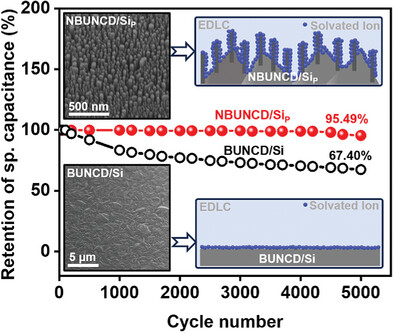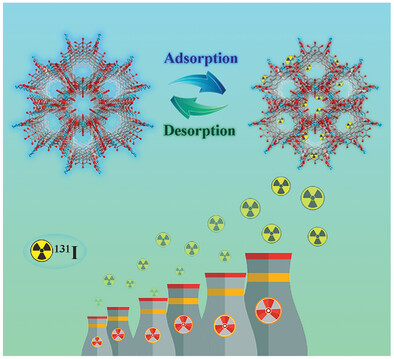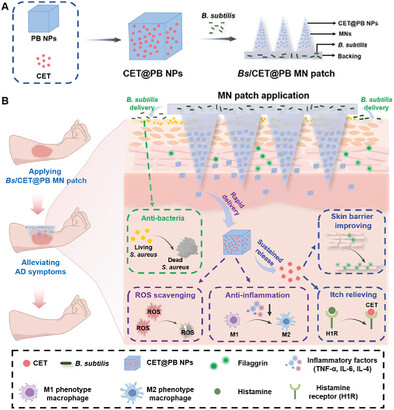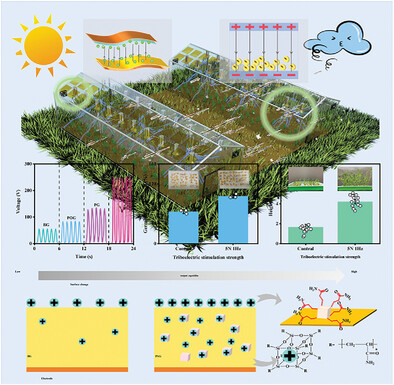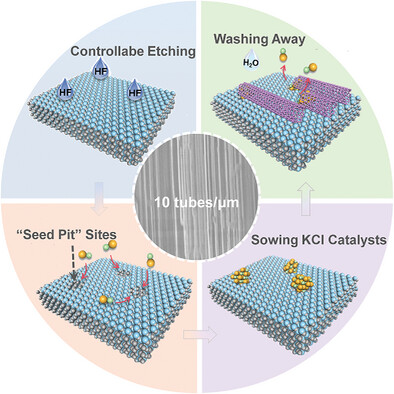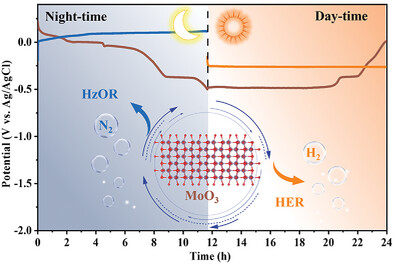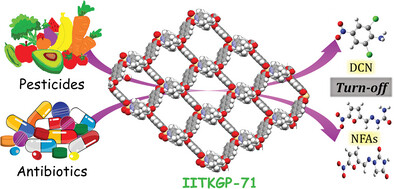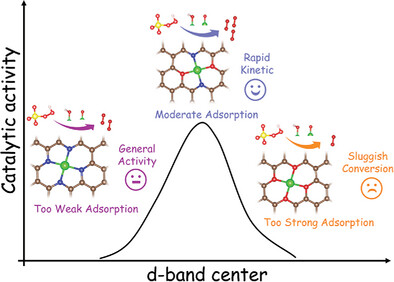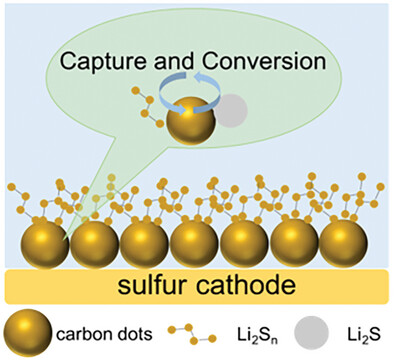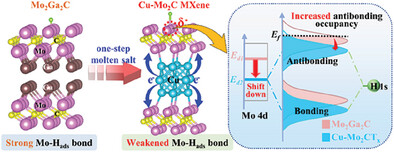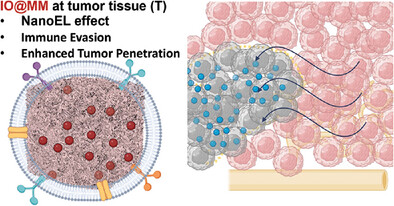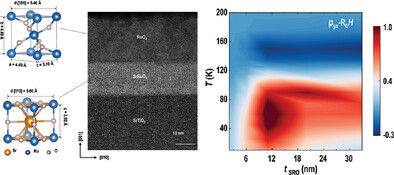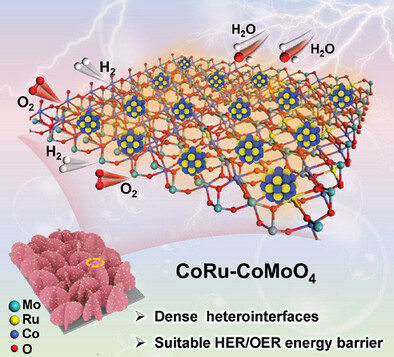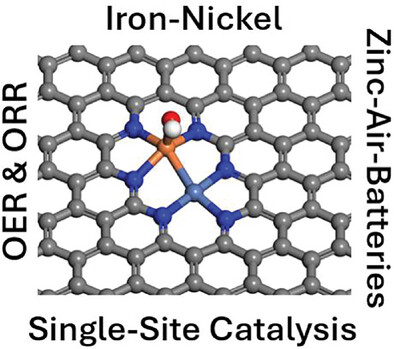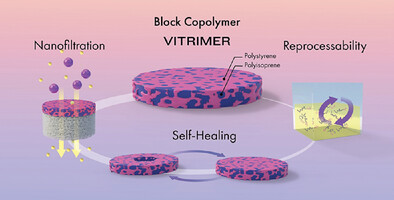Journal list menu
Export Citations
Download PDFs
Cover Picture
Guided Heterostructure Growth of CoFe LDH on Ti3C2Tx MXene for Durably High Oxygen Evolution Activity (Small 3/2025)
- First Published: 22 January 2025
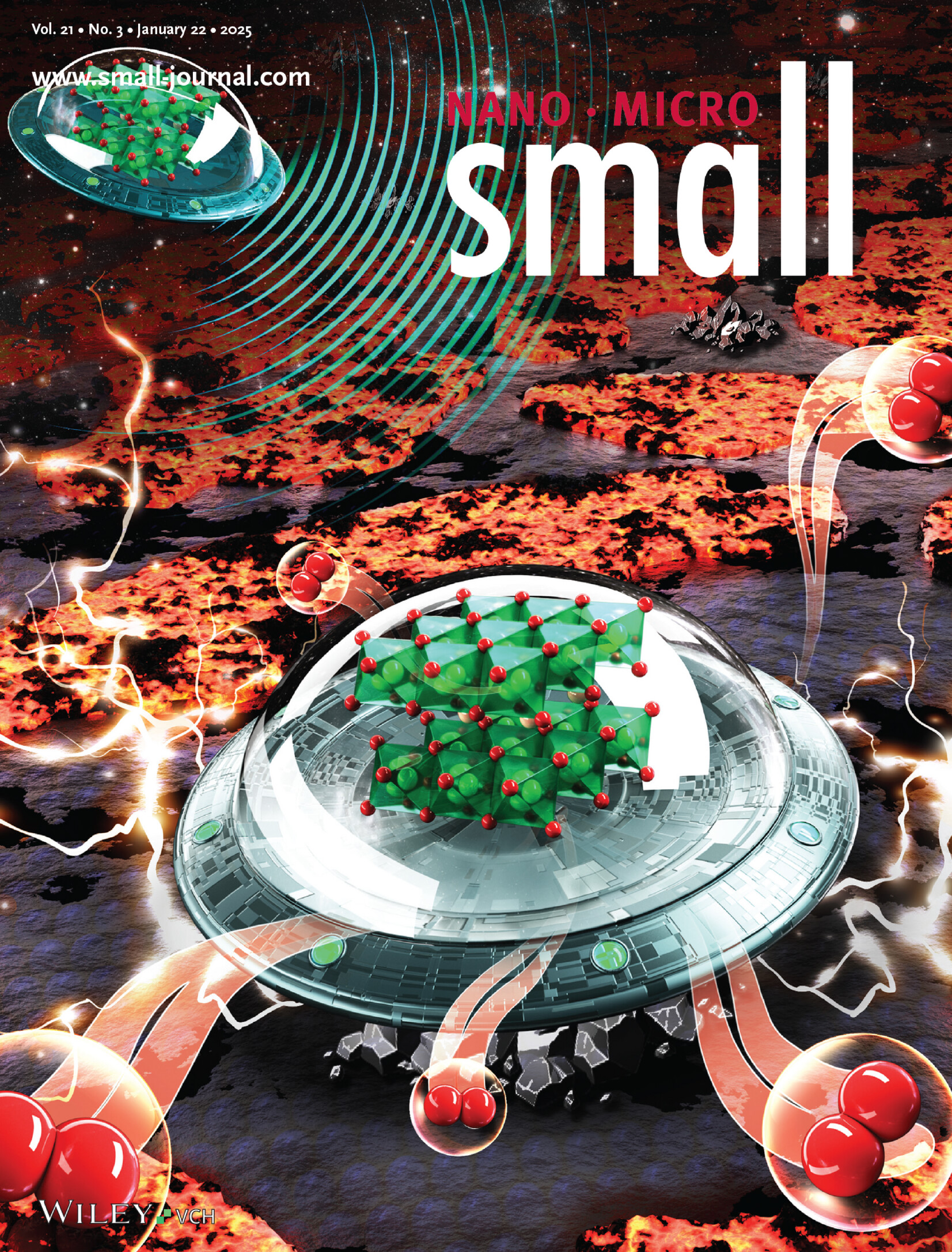
Oxygen Evolution
In article number 2404927, Hannu-Pekka Komsa, Bo Peng, Zhong-Peng Lv, and co-workers unveiled the guided growth of Co/Fe layered double hydroxide nanosheets (LDH) via the terminations on Ti3C2Tx MXene surface. The MXene surface chemistry regulates the structure and electronic properties in LDH-MXene heterostructures. A remarkably robust oxygen evolution reaction performance is demonstrated, where the overpotential only decays by 0.1% over 200 h operation.
Inside Front Cover
Isomerization of Covalent Organic Frameworks for Efficiently Activating Molecular Oxygen and Promoting Hydrogen Peroxide Photosynthesis (Small 3/2025)
- First Published: 22 January 2025
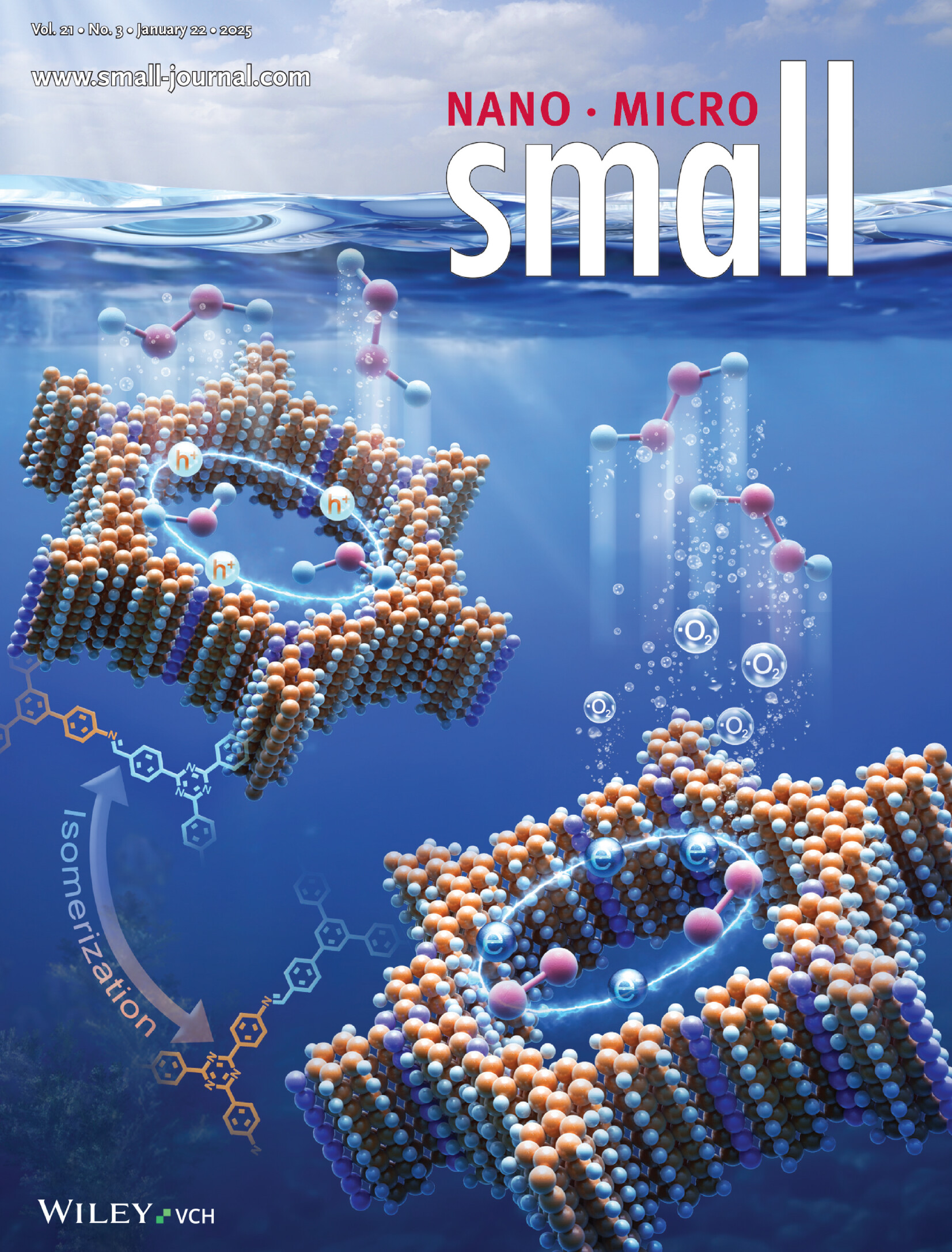
Covalent Organic Frameworks
For a pair of isomeric covalent organic frameworks (COFs), different rate determining steps were proved in the generation process of H2O2. PB-PT-COF showed strong interaction with H2O, facilitating the direct oxidation of H2O (H2O + h+→H2O2), while PT-PB-COF exhibited effective O2 adsorption and activation (O2 + e- → •O2− + e− → H2O2), resulting in a twofold enhancement in the H2O2 photosynthesis. More in article number 2406527, Xuepeng Wang, Fuquan Bai, Wei Zhou, and co-workers.
Inside Back Cover
Shortwave Infrared Imaging of a Quantum Dot-Based Magnetic Guidewire Toward Non-Fluoroscopic Peripheral Vascular Interventions (Small 3/2025)
- First Published: 22 January 2025

Peripheral Vascular Interventions
In article number 2404251, Jin-young Kim, Hongsoo Choi, and co-workers investigate a quantum dot (QD) magnetic guidewire and system for non-fluoroscopic peripheral vascular interventions. By leveraging HgCdSe/HgS/CdS/CdZnS/ZnS/SiO2 core/multi-shell QD-embedded elastomeric composites with real-time short-wave infrared (SWIR) imaging and magnetic manipulation, the guidewire enables SWIR detection upon near-infrared excitation for X-ray-free imaging and can be precisely guided through complex blood vessels using an external magnetic field.
Back Cover
Enhanced Positive Charge Performance in Triboelectric Series: Molecular Engineering of Conjugated Mesoporous Fibers for Machine Learning-Based Wearable Sensors (Small 3/2025)
- First Published: 22 January 2025
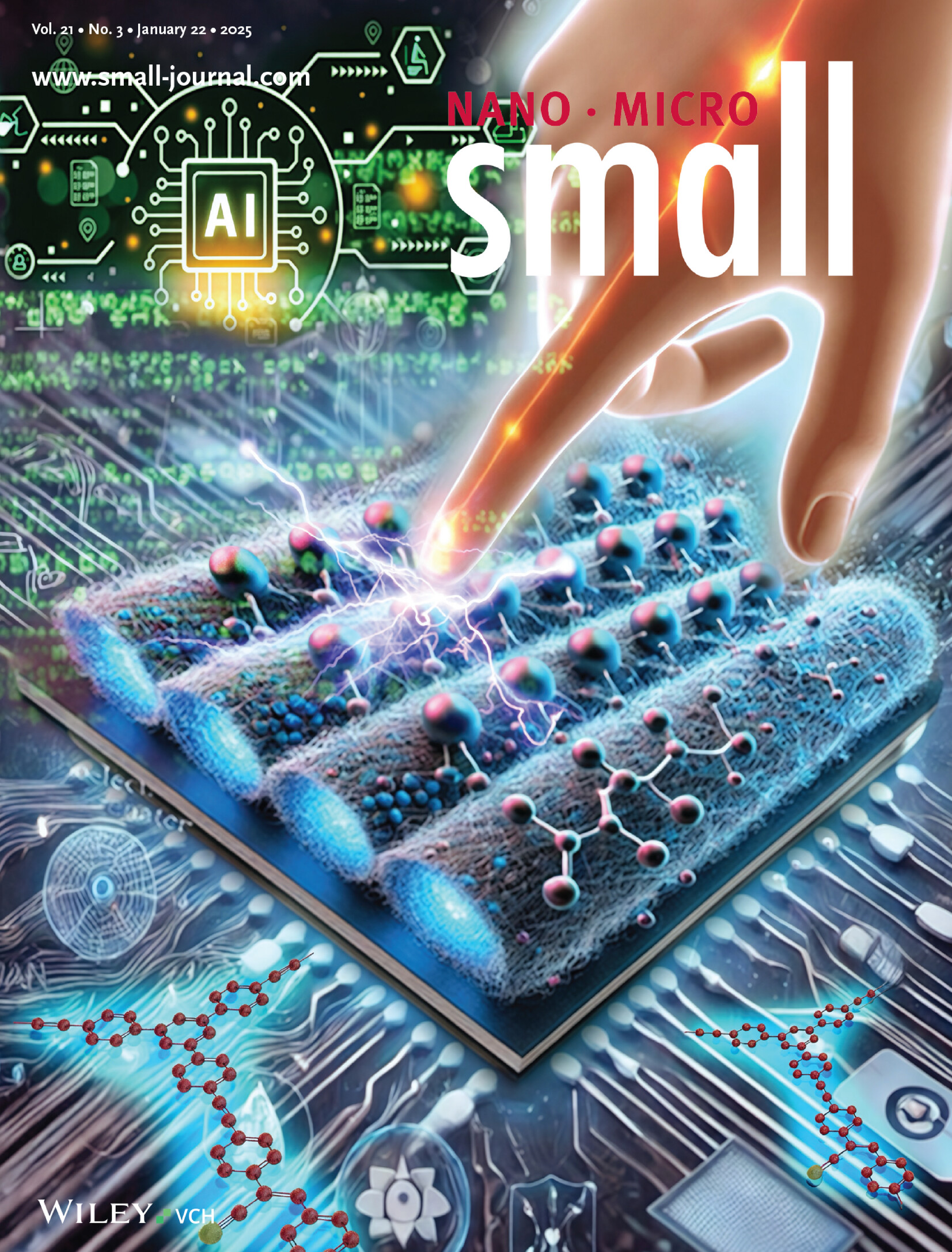
Wearable Sensors
In article number 2404737, Hyungwoo Kim, Jong-jin Park, and co-workers address the scarcity of positively-charged triboelectric materials by designing a conjugated, mesoporous, self-assembled sheet via bottom-up synthesis. Functionalized as a triboelectric nanogenerator, it enhances positive triboelectric performance and boosts output voltage when in contact with PTFE. Demonstrated as a touchpad for symbol writing, it integrates with machine learning for real-time medical applications.
Issue Information
Review
Impact of Interfaces on the Performance of Covalent Organic Frameworks for Photocatalytic Hydrogen Production
- First Published: 18 November 2024
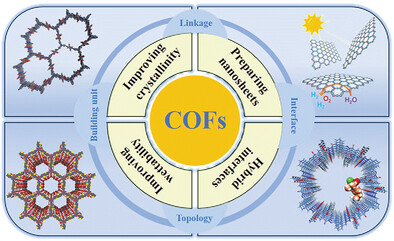
COFs are promising candidates for photocatalytic hydrogen production. Significant progress has been made in the last decade. However, there is a lack of review of the field of photocatalytic hydrogen production from the perspective of interface modulation. This mini-review discusses general strategies to enhance COFs photocatalytic activity through interfacial influences. Highlighting the effects of hybrid interfaces on the performance of COFs for photocatalytic hydrogen evolution is presented. The insights into the challenges and opportunities of solid-liquid interfacial modulation of COFs to enhance photocatalytic activity are also provided.
Biomimetic Mineralized Collagen Scaffolds for Bone Tissue Engineering: Strategies on Elaborate Fabrication for Bioactivity Improvement
- First Published: 24 November 2024
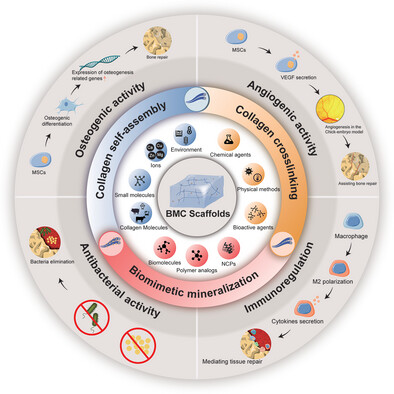
Biomimetic mineralized collagen (BMC) scaffolds represent an innovative class of bio-inspired biomaterials for bone tissue engineering. In this review, based on the BMC preparation procedures, the substances that can regulate both the fabrication process and biological activities are summarized. Furthermore, a potential strategy for developing BMC scaffolds with superior mechanical properties and biological activities for bone tissue engineering is proposed.
How Much Force is Needed to Kill a Single Bacterium?
- First Published: 20 November 2024
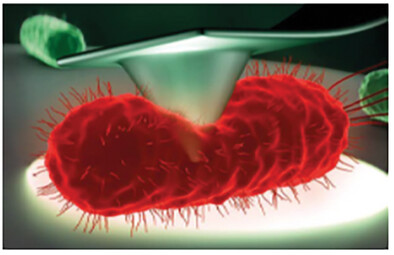
The quantification of the forces necessary to rupture the cell wall of a bacterium is relevant to understanding, for example, the action mechanisms of mechanobactericidal nanomaterials. This perspective collects and compares recent work on bacterial nanoindentation beyond rupture using atomic force microscopy. The influence of environmental and experimental parameters on the measured rupture forces is discussed, as well as the non-trivial transformation of force values into pressures.
Atomically Precise Metal–Metal Oxide Interface in Polyoxometalate-Noble Metal Hybrid Clusters
- First Published: 20 November 2024
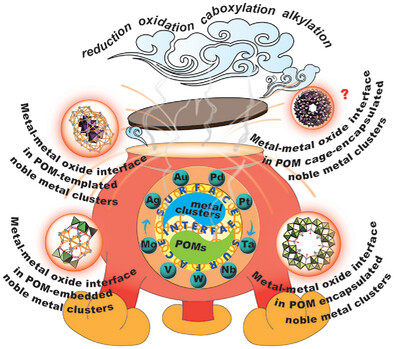
Different from other reviews focusing on the structures and properties of polyoxometalates (POMs)-noble metal hybrid clusters, this review mainly discusses the interface structures and electronic correlations between POMs and noble metals via their atomically precise structures, in order to understanding the factors influencing the catalysis and establishing structure-property relationships at the atomic scale.
Recent Advances in Nanomaterial-Based Biosignal Sensors
- First Published: 28 November 2024
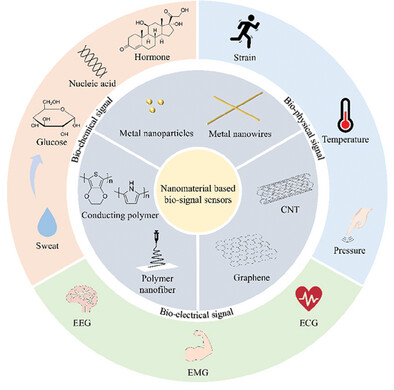
Biosignal sensors leveraging the unique mechanical, electrical, and optical properties of nanomaterials have been extensively studied. In this review, it is classified and introduce three types of biosignal sensors utilizing nanomaterials: biophysical sensors, bioelectrical sensors, and biochemical sensors. Furthermore, the potential of nanomaterial-based biosignal sensors by providing a perspective on biosignal analysis through deep learning and their applications as human-machine interfaces is explored.
PEO-Based Solid-State Polymer Electrolytes for Wide-Temperature Solid-State Lithium Metal Batteries
- First Published: 26 November 2024
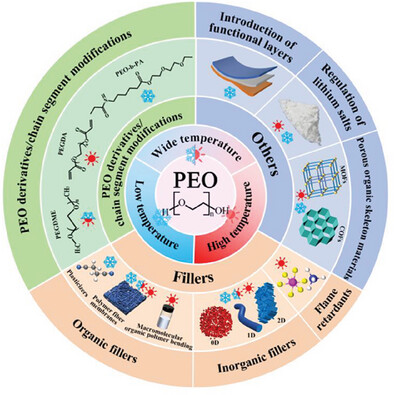
Based on analyzing the modification mechanisms of PEO-based solid electrolytes at various temperatures, the modification methods of PEO electrolytes in a wide temperature field are reviewed. The application of more efficient modification methods in the future can broaden the working fields of solid-state lithium metal batteries to effectively promote their rapid development.
Towards High-Performance Li-Rich Cathode Materials: from Morphology Design to Electronic Structure Modulation
- First Published: 15 December 2024
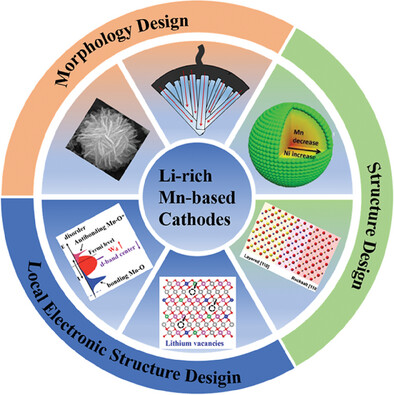
This review provides a comprehensive summary of the recent progress in understanding the structure and electrochemical mechanisms of lithium-rich manganese-based layered cathode materials. It highlights multiscale modification strategies, covering advancements from morphology control to electronic structure optimization, offering insights for future research directions.
Biomimetic Materials for Antibacterial Applications
- First Published: 22 November 2024

The rise of bacterial resistance has driven the development of innovative antimicrobial strategies, particularly biomimetic antibacterial materials. This review offers a comprehensive overview of their recent advancements, addresses the challenges faced, and explores future developmental directions, highlighting their potential to transcend current treatment limitations.
Recent Advances in Metal Halide Perovskites for CO2 Photocatalytic Reduction: An Overview and Future Prospects
- First Published: 30 November 2024
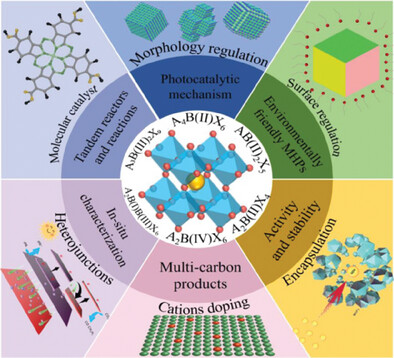
This review summarizes the latest advancements in metal halide perovskites (MHP)-based photocatalysis. First the fundamental principles of photocatalysis are outlined and the structural and optical characteristics of MHPs are evaluated. Then key strategies for enhancing MHP photocatalysts, including morphology and surface modification, encapsulation, metal cation doping, heterojunction engineering, and molecular immobilization are highlighted. Finally, challenges and future prospects are explored.
Unveiling Covalent Triazine Frameworks for Lithium Metal Anodes: Recent Developments and Prospective Advances
- First Published: 04 December 2024
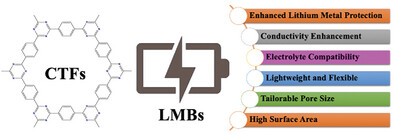
This review explores the potential of Covalent Triazine Frameworks (CTFs) in mitigating lithium dendrite formation and enhancing the stability of Lithium Metal Batteries (LMBs). By leveraging CTFs’ unique properties such as high surface area, chemical stability, and lithium-accepting N-containing groups, strategies for improving cycling efficiency is discussed and ensuring the safety of LMBs for practical applications.
Frontispiece
A Biodegradable, Porous Flier Inspired by a Parachute-Like Tragopogon Fruit for Environmental Preservation (Small 3/2025)
- First Published: 22 January 2025
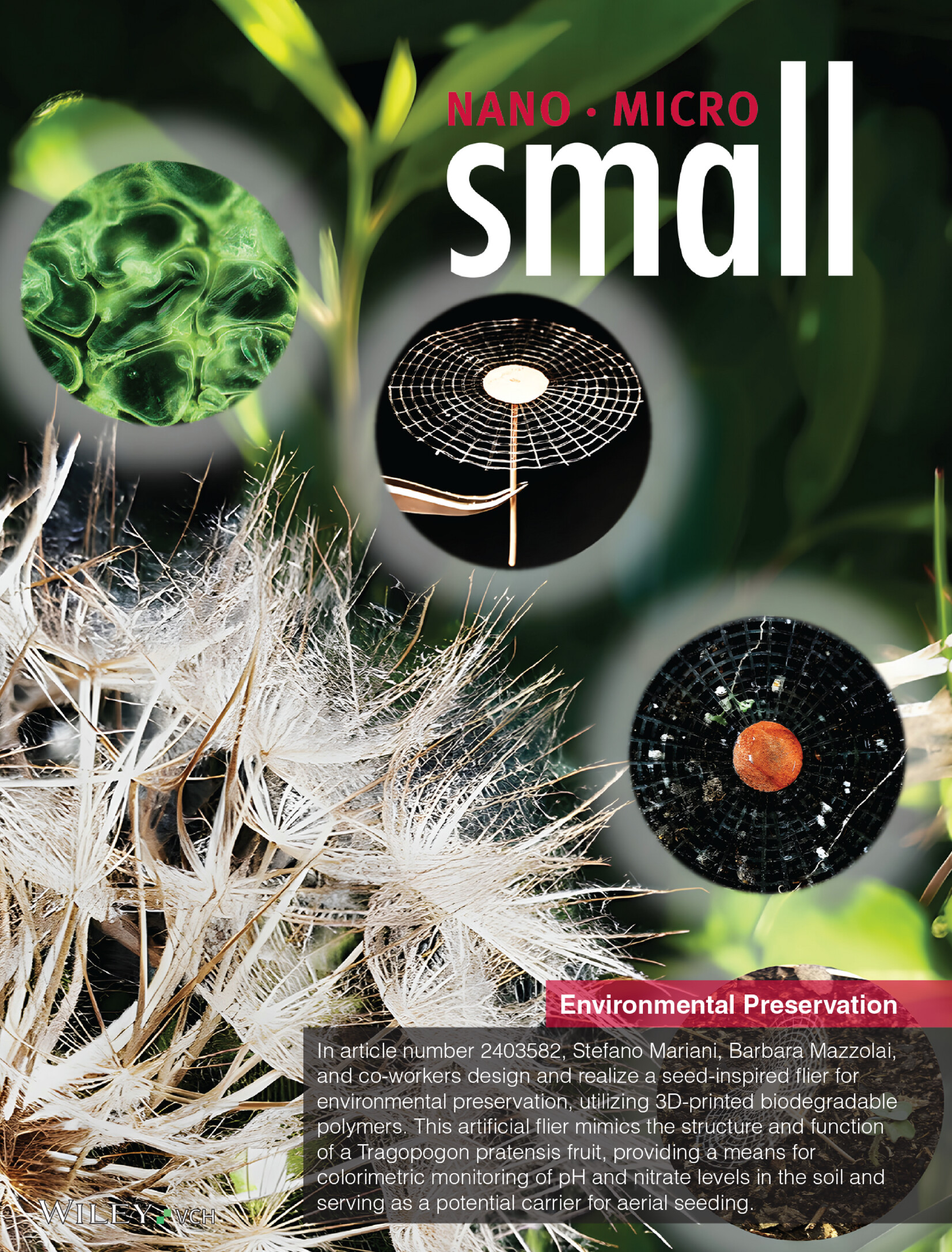
Environmental Preservation
In article number 2403582, Stefano Mariani, Barbara Mazzolai, and co-workers design and realize a seed-inspired flier for environmental preservation, utilizing 3D-printed biodegradable polymers. This artificial flier mimics the structure and function of a Tragopogon pratensis fruit, providing a means for colorimetric monitoring of pH and nitrate levels in the soil and serving as a potential carrier for aerial seeding.
Research Article
A Biodegradable, Porous Flier Inspired by a Parachute-Like Tragopogon Fruit for Environmental Preservation
- First Published: 17 September 2024

A fruit-like, biodegradable, and porous parachute flier is realized for environmental preservation. The coupling of biological analysis, modeling, design, and additive manufacturing of porous cellulose acetate (with micrometric features) allow the fabrication of a flier resembling the Tragopogon pratensis aerodynamics. The fliers offer a solution for colorimetric monitoring of soil pH and nitrate or as carrier for aerials seeding.
Frontispiece
Selective Void Deposition by Continuous, Ultrathin Ag Film Enabled Stable, High-Performance AgNWs-Based Transparent Heaters (Small 3/2025)
- First Published: 22 January 2025
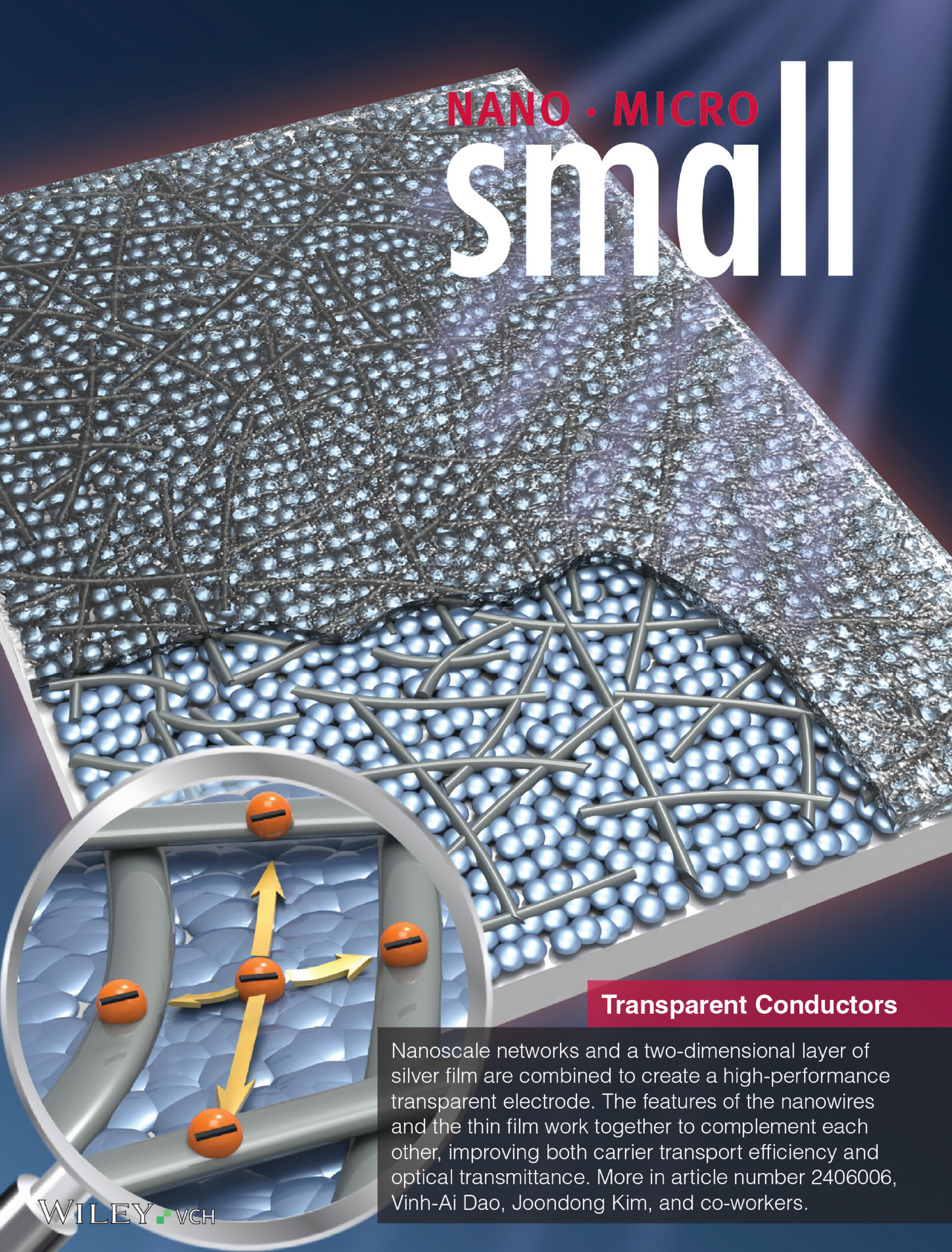
Transparent Conductors
Nanoscale networks and a two-dimensional layer of silver film are combined to create a high-performance transparent electrode. The features of the nanowires and the thin film work together to complement each other, improving both carrier transport efficiency and optical transmittance. More in article number 2406006, Vinh-Ai Dao, Joondong Kim, and co-workers.
Research Article
Selective Void Deposition by Continuous, Ultrathin Ag Film Enabled Stable, High-Performance AgNWs-Based Transparent Heaters
- First Published: 13 October 2024
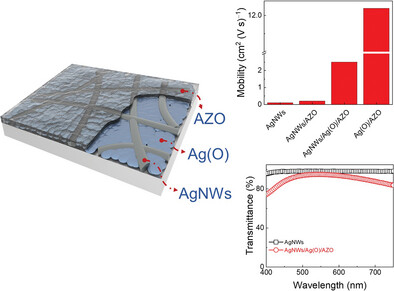
2D Ag thin-film selectively forms into macro-voids of the AgNWs network. The continuous 2D Ag at a thickness of 6 nm is a bridge connecting individual AgNWs to enhance the lateral conduction of the network. Optical engineering by the high refractive index of an overcoat material, AZO, enables AgNWs-based transparent conductors to be highly transparent and stable.
Frontispiece
Self-Oxidated Hybrid Conductive Network Enables Efficient Electrochemical Lithium Extraction Under High-Altitude Environment (Small 3/2025)
- First Published: 22 January 2025
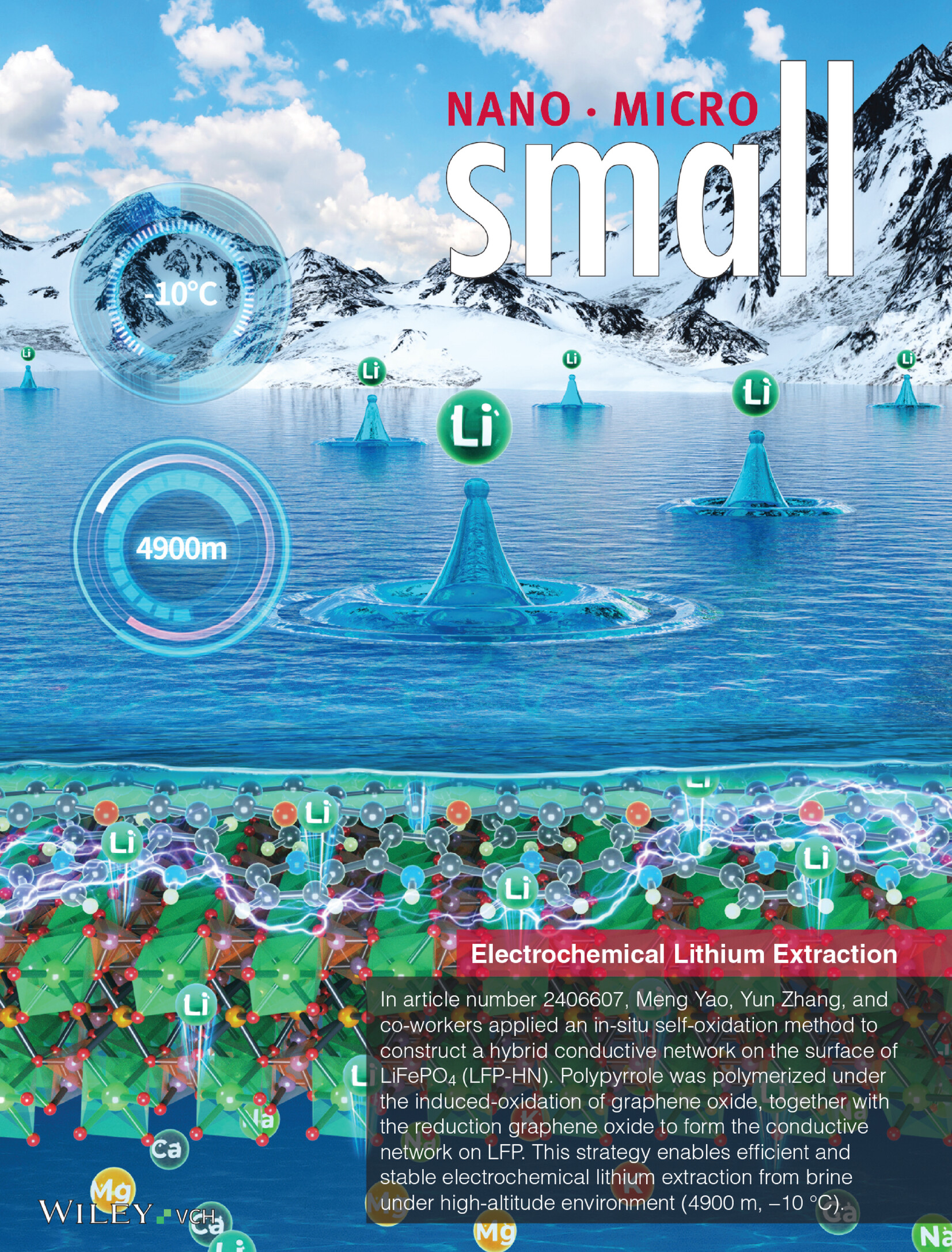
Electrochemical Lithium Extraction
In article number 2406607, Meng Yao, Yun Zhang, and co-workers applied an in-situ self-oxidation method to construct a hybrid conductive network on the surface of LiFePO4 (LFP-HN). Polypyrrole was polymerized under the induced-oxidation of graphene oxide, together with the reduction graphene oxide to form the conductive network on LFP. This strategy enables efficient and stable electrochemical lithium extraction from brine under high-altitude environment (4900 m, −10 °C).
Research Article
Self-Oxidated Hybrid Conductive Network Enables Efficient Electrochemical Lithium Extraction Under High-Altitude Environment
- First Published: 04 October 2024
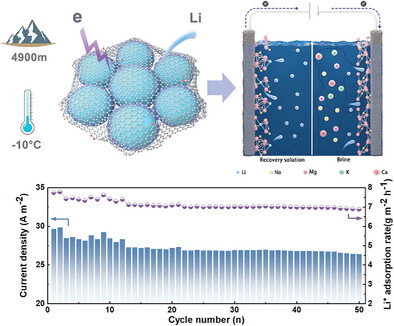
The LFP with a hybrid network (LFP-HN) is constructed via the in situ self-oxidation method. The hybrid network enhances the interfacial electron/lithium-ion transfer kinetics and strengthens structural stability by suppressing the deintercalation of impurity cations. As a result, the LFP-HN enables a superior lithium extraction current density of 26.72 A m−2 with excellent cyclic stability in Baqiancuo real brine.
Guided Heterostructure Growth of CoFe LDH on Ti3C2Tx MXene for Durably High Oxygen Evolution Activity
- First Published: 10 September 2024
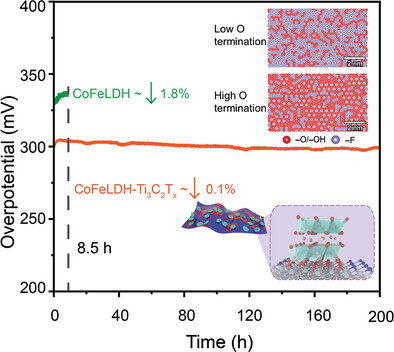
Challenges remain for growth high performance and robust heterostructures of 2D layered double hydroxides (LDH) and MXenes, which hold great promise for energy conversion systems. By selecting different Ti3C2Tx MXene surface chemistry, the researchers discovered that the growth of CoFe LDH nanosheets are guided by the terminations on Ti3C2Tx surface. The resulting LDH-MXene heterostructure shows surprisingly robust oxygen evolution reaction performance.
Isomerization of Covalent Organic Frameworks for Efficiently Activating Molecular Oxygen and Promoting Hydrogen Peroxide Photosynthesis
- First Published: 27 September 2024
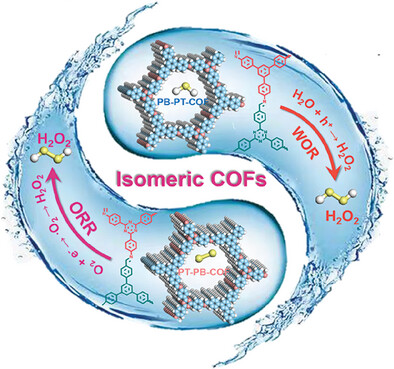
Combined with theoretical calculations and experimental results, it is proved that different rate determining steps are exhibited in the H2O2 generation process for a pair of isomeric COFs (PB-PT-COF and PT-PB-COF). PB-PT-COF shows strong interaction with H2O, facilitating the direct oxidation of H2O, while PT-PB-COF exhibited effective adsorption and activation of molecular oxygen, resulting in a 2-fold enhancement in the H2O2 photosynthesis.
Shortwave Infrared Imaging of a Quantum Dot-Based Magnetic Guidewire Toward Non-Fluoroscopic Peripheral Vascular Interventions
- First Published: 23 August 2024
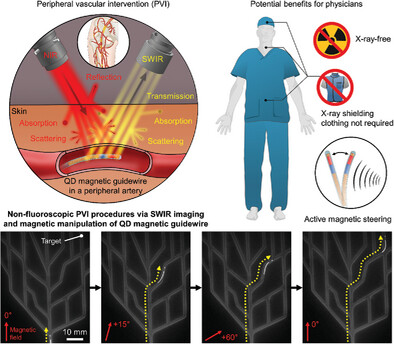
Interventional physicians are at risk of X-ray side effects due to the inevitable use of fluoroscopy, while the precise steering of guidewires is an additional challenge during peripheral vascular interventions (PVIs). Taking advantage of quantum dots, shortwave infrared imaging, and magnetic manipulation, this paper explores the potential of a quantum dot-based magnetic guidewire and its system for realizing X-ray-free PVI procedures.
Enhanced Positive Charge Performance in Triboelectric Series: Molecular Engineering of Conjugated Mesoporous Fibers for Machine Learning-Based Wearable Sensors
- First Published: 29 August 2024

This study addresses the scarcity of positively-charged triboelectric materials by designing a conjugated, mesoporous, self-assembled sheet via bottom-up synthesis. Functionalized as a triboelectric nanogenerator, it enhances positive triboelectric performance and boosts output voltage when in contact with PTFE. Demonstrated as a touchpad for symbol writing, it integrates with machine learning for real-time medical applications.
Nanostructured Boron-Doped Ultra-Nanocrystalline Diamond Micro-Pyramids: Efficient Electrochemical Supercapacitors
- First Published: 15 December 2024
Stable, Full-Color, Long-Lasting Aqueous Room-Temperature Phosphorescent Materials
- First Published: 15 December 2024
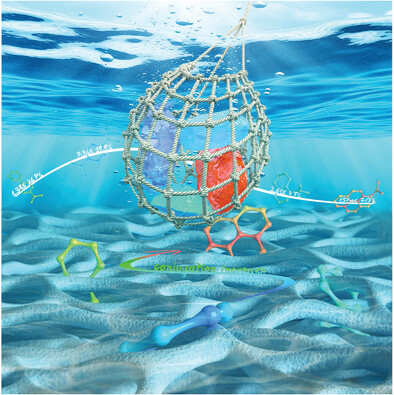
Ultra-long room-temperature phosphorescent (URTP) materials offer promising applications in anti-counterfeiting and optoelectronics. This study introduces a one-step microwave method to produce full-color aqueous URTP materials by embedding guest molecules in a rigid cyanuric acid (CA) matrix. The resulting materials, with lifetimes up to 7.96 s, retain visible afterglow in water and achieve a phosphorescence quantum yield of 40.4%.
A Novel kgd-Topological Covalent Organic Framework with Optimum Pore Size for Efficient Benzene/Cyclohexane Separation
- First Published: 20 November 2024
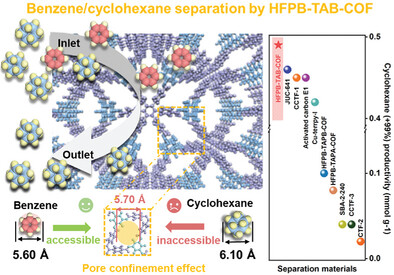
A novel kgd-topological covalent organic framework (HFPB-TAB-COF) is synthesized, having an average pore size of 5.70 Å which is finely tuned between the kinetic diameters of benzene (5.60 Å) and cyclohexane (6.10 Å). The optimization of pore size enables HFPB-TAB-COF to achieve a remarkable ideal adsorbed solution theory (IAST) selectivity of 36.0 and yield 0.48 mmol g−1 cyclohexane (purity ≥ 99%) for benzene/cyclohexane separation by pore confinement effect.
Proton-Mediated Dynamic Nestling of DNA Payloads Within Size-Matched MOFs Nanochannels for Smart Intracellular Delivery
- First Published: 26 November 2024
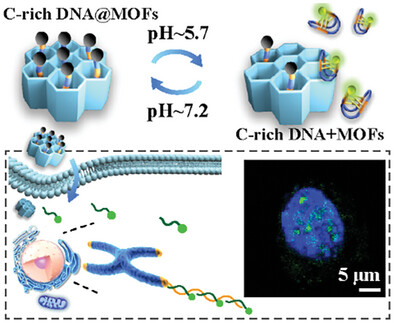
The dynamic interaction between the nanochannels of mesoporous metal-organic frameworks (MOFs), the Ni-IRMOF-74 series, and i-motif DNA strands exhibiting pH-responsive conformational changes is investigated. The nanochannels can accommodate these DNA strand at neutral pH, while under acidic conditions, the tendency of the strand to form a four-stranded structure drives the release of the strand. Moreover, the proton-mediated dynamic interaction between the MOFs nanochannels and DNA strands can be coupled with the endocytosis processes, and the imaging of nucleus telomeres can be achieved due to the sequence complementarity between the i-motif DNA strand and telomere overhangs.
Multifunctional Amphoteric Additive Alanine Enables High-Performance Wide-pH Zn Metal Anodes
- First Published: 13 November 2024
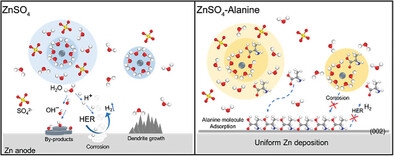
Polar amphoteric alanine preferentially adsorbs onto the surface of Zn anodes in both acidic and alkaline electrolytes, which leads to a water-deficient and Ala-enriched interfacial electric double layer. Alanine promotes a uniform, compact, flat, dendrite-free Zn deposition, changes the solvation sheath structure of hydrated Zn2+, and inhibits corrosion and side reactions. Alanine effectively stabilizes Zn anodes in both acidic and alkaline electrolytes.
Hydrogen-Bonded Organic Framework and Metal–Organic Framework Assembly of Waterwheel PgC-Noria Molecule: Regulating Microstructure Enables Iodine Transfer
- First Published: 16 November 2024
Boosting Photoconductivity by Increasing the Structural Complexity of Multivariate Covalent Organic Frameworks
- First Published: 20 November 2024
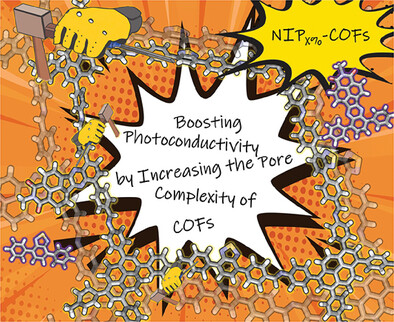
The assessment of the photoconductivity of Donor-Acceptor (D-A) bulk heterojunctions is garnering attention for developing innovative organic semiconductors. Here, the synthesis of a Naphthaleneimide Covalent Organic Frameworks (NIPX%COFs), created through a multivariate reaction involving two distinct acceptors is presented. Consequently, it is observed that the photoconductivity exhibits a Volcano-type correlation with respect to the NIP% content.
Natural Size Variation Amongst Protocells Leads to Survival and Growth Under Hypoosmotic Conditions
- First Published: 04 December 2024
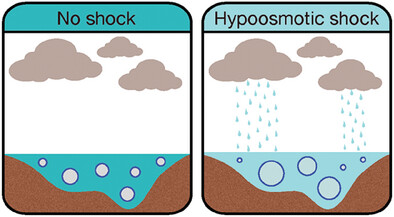
Model protocells can tolerate a surprising amount of hypoosmotic stress. Redistributing monomers within a population enables fatty acid vesicles to tolerate substantial hypoosmotic stresses through membrane growth, whilst still retaining a significant proportion of their contents. Thus rather than being an environmental stressor, hypoosmotic stress becomes a driving force for population growth.
Hierarchical Porous Structured Si/C Anode Material for Lithium-Ion Batteries by Dual Encapsulating Layers for Enhanced Lithium-Ion and Electron Transports Rates
- First Published: 18 November 2024

This work utilizes the multifunction of sodium polyacrylate to develop a hierarchical porous silicon–carbon anode (Si/SiOx@C), which consists of nano-silicon cores, SiOx encapsulating layers, surrounding space, and phenolic resin-derived carbon shells with carbon chains connecting the SiOx layers and carbon shells in the space. These structures synergize with each other to facilitate lithium-ion and electron transport throughout the electrode material.
Hierarchically Structured and Tunable Hydrogel Patches: Design, Characterization, and Application
- First Published: 20 November 2024
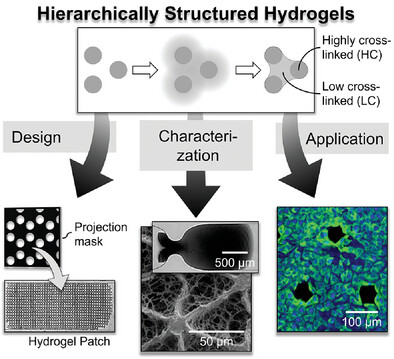
This work presents hierarchically structured hydrogel networks, so-called hydrogel patches, with internally deviating highly crosslinked (HC) and low crosslinked (LC) regions on a micron-scale. These regions are entirely tailorable and pre-defined in a one-step, high-throughput fabrication. Thus, their characteristics, e.g. their porosity or their mechanical characteristics, are adjustable, introducing the patches as promising and versatile platform systems.
Silver(I)-Mediated 2D DNA Nanostructures
- First Published: 20 November 2024
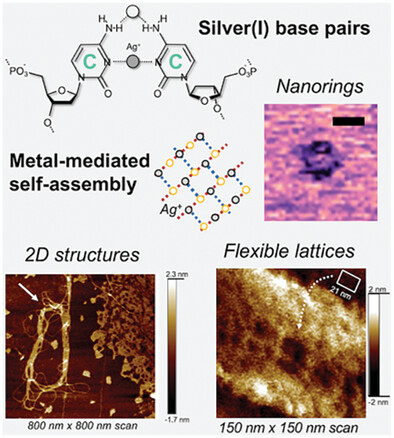
Cytosine-silver(I)-cytosine base pairs are used to construct a library of DNA nanostructures. These nanorings and lattices assemble only in the presence of silver ions and possess tunable metal composition and pitch. This study presents a crucial step toward nanoscale circuit design based on metal base pairs.
A Ratiometric Time-Gated Luminescence Probe for Imaging H2O2 in Endoplasmic Reticulum of Living Cells and Its Application to Smartphone-Guided Bioimaging
- First Published: 26 November 2024
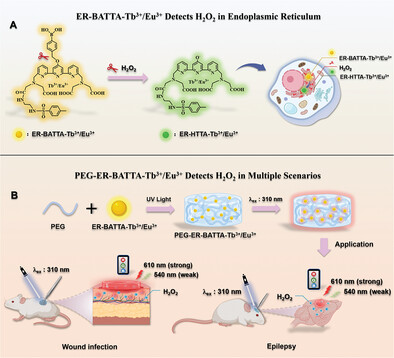
A lanthanide complex-based ER-targetable probe has been developed for ratiometric time-gated luminescence sensing and imaging of H2O2 in the endoplasmic reticulum in vitro and in vivo. By integrating the probe into PEG hydrogels, H2O2-responsive smart sensor films are developed, enabling real-time monitoring of H2O2 levels in various wounds and brains of epileptic rats.
Synchronization of E. coli Bacteria Moving in Coupled Microwells
- First Published: 25 November 2024
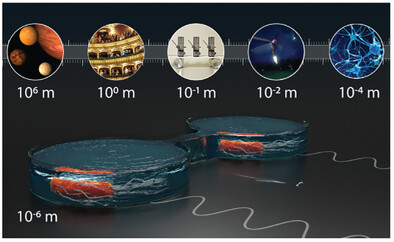
Synchronization plays a crucial role in biology and physics, across different time and length scales. Here, the discovery of hydrodynamic synchronization amongst one of the smallest living organisms, E. coli bacteria, is reported, wheir their random motion is tamed and their swimming patterns are synced by using coupling microcavities.
Charge Separation-Engineered Piezoelectric Ultrathin Nanorods Modulate Tumor Stromal Microenvironment and Enhance Cell Immunogenicity for Synergistically Piezo-Thermal-Immune Therapy
- First Published: 16 November 2024

After the in situ modification of Pt on BiVO4, a heterojunction called BVP is formed for tumor piezo-thermal-immune therapy. The efficiency of BVP in photothermal and catalyzing the production of ROS is improved after Pt modification, and it also enhances the production of oxygen. This reshapes the tumor microenvironment, boosting immunotherapy efficacy, and triggering tumor cell death through immunogenic cell death.
Minimizing Voltage Deficit in Perovskite Indoor Photovoltaics by Interfacial Engineering
- First Published: 15 November 2024
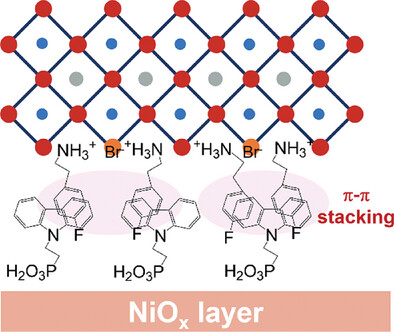
The open circuit voltage deficit of perovskite indoor photovoltaic (IPV) devices is effectively minimized by modifying the buried interface of perovskite layer with bifunctional molecular 2-(4-Fluorophenyl)ethylamine Hydrobromide (F-PEABr). The modified perovskite IPVs have achieved a high power conversion efficiency of 42.3% with VOC of 1.13 V under 1000 lux LED illumination.
Interplay Between Calcination Temperature and Alkaline Oxygen Evolution of Electrospun High-Entropy (Cr1/5Mn1/5Fe1/5Co1/5Ni1/5)3O4 Nanofibers
- First Published: 24 November 2024
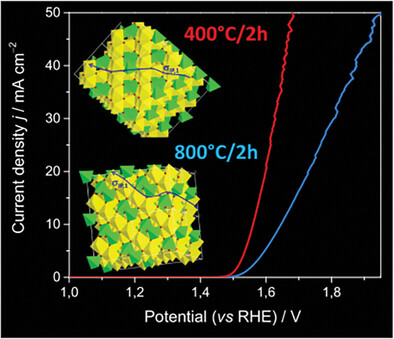
Spinel-type high-entropy (Cr,Mn,Fe,Co,Ni) oxide nanofibers are evaluated as electrocatalysts for alkaline oxygen evolution reactions. Broadband electric spectroscopy, for the first time applied to unveil the nanostructural features that play a key role in this reaction, reveals that the mobility of surface oxygen vacancies is primarily associated with very fast local distortional relaxation modes of O-deficient MO6 octahedra.
Molecular Propeller Tethering on a Dipeptide Induces a One-Step Conversion of Its Secondary Structure on Water Surface Promoted by Chiral Supramolecular Assembly
- First Published: 28 November 2024

Precisely controlled one-step conversion from β-sheet to α-helix structure of an amyloid-derived dipeptide system on the water surface is reported here. Spherical aggregates and molecular wires with β-sheet structure are converted into 2D sheets featuring a large planar area yet with molecular-level thickness containing α-helix structure. Dynamic changes in the dihedral (intramolecular) angle between aromatic rings alter intermolecular H-bonds and binding energies essential for the total secondary structural transformation.
Uncovering the Salt-Controlled Porosity Regulation in Coal-Derived Hard Carbons for Sodium Energy Storage
- First Published: 20 November 2024
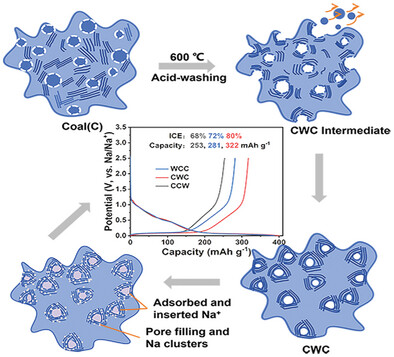
The representative salty coal is subjected to a two-step pyrolysis procedure, during which the acid removal process is selectively inserted. Salt acts as a templates or activating medium to induce open pores during the low-temperature pyrolysis but hinders the closure of open pores during the high-temperature carbonization. The optimized HC delivers a high plateau capacity and a high energy density.
Double-Layered Microneedle Patch Integrated with Multifunctional Nanoparticles and Live Bacteria for Long-Term Treatment of Atopic Dermatitis
- First Published: 15 November 2024
Sulfate Oxyanion Steered d-Orbital Electronic State of Nickel-Iron Nanoalloy for Boosting Electrocatalytic Performance
- First Published: 15 November 2024
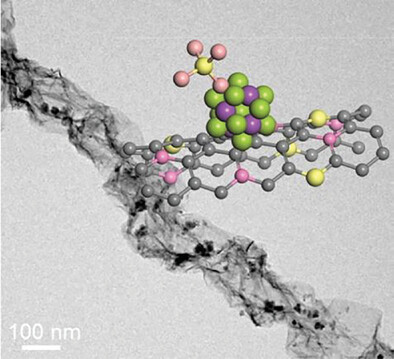
The oxyanionic groups provide a brand-new strategy to improve the performance of active sites owing to their great functionalities in affecting the orbital electronic states. In this work, the sulfate oxyanion (SO42−) is designed onto the NiFe nanoalloy surface. The considerably enhanced electrocatalytic activity of SO42−-NiFe/NSCT electrocatalyst is studied, and the in-depth mechanism is explored.
Electric Field-Induced Synergetic Enhancement of Local Hydroxyl Concentration and Photogenerated Carrier Density for Removal of COads in Electrocatalytic Formic Acid Oxidation
- First Published: 12 December 2024
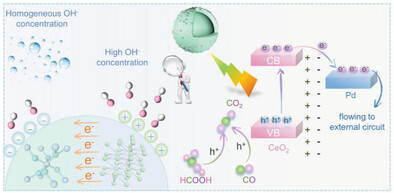
In this paper, a new strategy to promote the oxidative removal of COads on the catalyst surface during the FAOR process is proposed. i.e., constructing the built-in electric field directed from Pd to CeO2. Driven by the built-in electric field, the photogenerated carrier density and local hydroxyl concentration are synergistically enhanced, thus accelerating the oxidation of COads intermediates and formic acid molecules and realizing the enhanced FAOR activity and stability.
Se-Doped CoS2@MoS2 Heterostructures on Multiwalled Carbon Nanotubes as Efficient Bifunctional Electrocatalysts for Alkaline Overall Water Splitting
- First Published: 18 November 2024
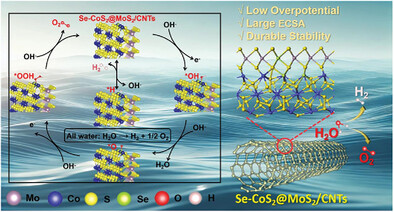
This figure illustrates the catalytic mechanism of Se-CoS2@MoS2/CNTs during water electrolysis, along with the molecular structure of the catalyst. The exceptional performance of the catalyst is demonstrated by its low overpotential, large electrochemically active surface area (ECSA), and long-term stability.
3D-Printed Hierarchical Nanostructured N-Co2NiO4 NF Electrode for Efficient Concurrent Electrocatalytic Production of Hydrogen and Formate
- First Published: 09 December 2024
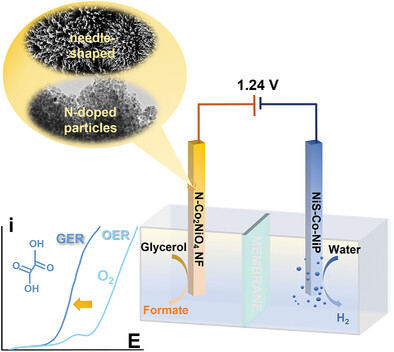
The nanostructured N-Co2NiO4 NF electrode is manufactured on 3D-printed substrate. With amorphous nitrogen-doping, the electrode exhibits outstanding activity for glycerol electro-oxidation reaction. The N-Co2NiO4 NF//NiS-Co-NiP system shows excellent performance for concurrent production of formate and hydrogen (1.24 V @10 mA m−2), leading to stable electrolysis at 150 mA cm−2 for 120 h with a high Faradaic efficiency of 97%.
High-Valence Co Stabilized by In-Situ Growth of ZIF-67 on NiCo-LDH for Enhanced Performance in Oxygen Evolution Reaction
- First Published: 15 November 2024
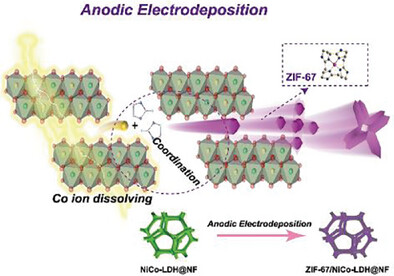
A multi-architecture oxygen evolution reaction (OER) catalyst is designed. NiCo-layered double hydroxide (NiCo-LDH) and zeolitic imidazolate frameworks-67 (ZIF-67) are grown on the surface of nickel foam by alternating cathodic and anodic electrodeposition, so as to realize the in situ growth of metal–organic framework without binder and to mildly product the low-cost controllable MOF-based catalysts.
Composite Solid-State Electrolyte with Vertical Ion Transport Channels for All-Solid-State Lithium Metal Batteries
- First Published: 16 November 2024

A composite solid-state electrolyte with vertically aligned, densely stacked ion transfer channels is prepared by aligning LLTO nanowires under a magnetic field, which can provide direct and abundant ion transfer channels between electrodes. This strategy allows scalable production and provides a promising solution for improving the electrochemical performance and energy density of ASSLBs.
Spin-Orbit Coupling Driven Magnetic Response in Altermagnetic RuO2
- First Published: 20 November 2024
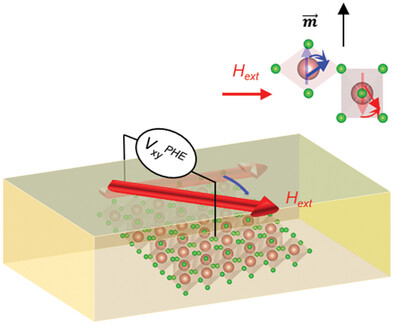
This study investigates magnetic responses in altermagnetic RuO2 films using the planar Hall effect (PHE). The films exhibit twofold PHE behavior and nonlinear planar Hall conductivity under rotating external fields, driven by spin-orbit coupling. These findings highlight RuO2's potential in advancing spintronics and exploring novel magnetic phenomena for future technological applications.
Dynamic Self-Healing of the Reconstructed Phase in Perovskite Oxides for Efficient and Stable Electrocatalytic OER
- First Published: 16 November 2024
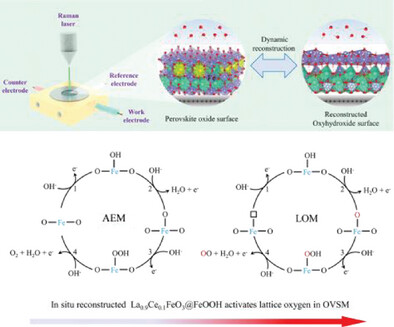
Perovskite oxide La1−xCexFeO3 moves dynamically between α-FeOOH active-layer and La1−xCexFeO3 regimes with applied electric potential, leading to excellent stability toward water oxidation involving lattice oxygen. With the assistance of the oxygen-vacancy-mediated redox pseudocapacitance, the as-prepared La0.9Ce0.1FeO3@FeOOH exhibits the lowest overpotential with 257 mV to achieve 10 mA cm−2, outperforming the benchmark IrO2@NF electrocatalysts.
Investigating the Effect of Carbon Nanotubes Decorated SmVO4-MoS2 Nanocomposite for Energy Storage Enhancement via VARTM-Fabricated Solid-State Structural Supercapacitors Using Woven Carbon Fiber
- First Published: 15 November 2024

This study presents a novel approach to integrating energy storage with structural functionality by synthesizing SmVO4-MoS2-CNT nanocomposites and optimizing CNT concentration for enhanced supercapacitor performance. Using VARTM, structural supercapacitor devices (SSDs) are fabricated, achieving high specific capacitance and cyclic stability, promising lightweight solutions for automotive and aerospace applications.
Reconstruction of Hole Transport Layer via Co-Self-Assembled Molecules for High-Performance Inverted Perovskite Solar Cells
- First Published: 17 November 2024
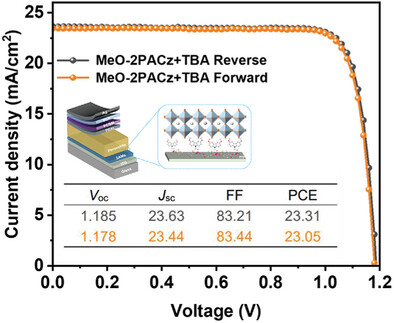
The Co-SAM strategy is employed in this study to blend the additive with MeO-2PACz as a hole transport material, aiming to address the inadequate coverage of MeO-2PACz as a hole transport layer, thereby impacting the efficiency of perovskite solar cells. By utilizing this approach, the photovoltaic performance of perovskite solar cells can be significantly enhanced, leading to a champion efficiency of 23.31%.
Bionanoparticles with In Situ Nitric Oxide Release for Precise Modulation of ER-TRPV1 Ion Channels in Multimodal Killing of Glioblastoma
- First Published: 25 November 2024

M-UCN-T encapsulates •NO donor and is coated with GL261 cell membrane and ER-targeting peptide is constructed. In response to NIR/GSH, M-UCN-T releases •NO in situ to activate the ER-TRPV1 ion channels and causes cytoplasmic Ca2+ overload, which induces inter-organelle signal crosstalk and triggers a cascade of immune cell death and apoptosis in tumor cells, and enhances T cell infiltration in tumor cells.
Waste-To-Energy: Sustainable Triboelectric Stimulating System Constructed by Bone Gelatin Based Triboelectric Nanogenerator for Crop Growth
- First Published: 21 November 2024
Isomeric Covalent Organic Frameworks for High-Efficiency Photocatalytic CO2 Reduction: Substituent Position Effect
- First Published: 26 November 2024
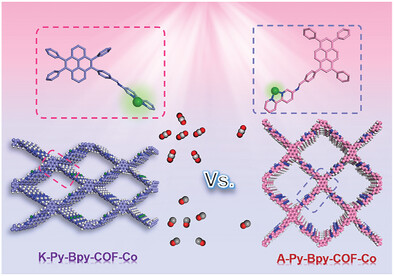
Highly efficient photocatalytic covalent organic frameworks toward CO2 reduction are successfully constructed via isomeric designed pyrene knots. K-Py-Bpy-COF-Co exhibited a 5.7-fold higher photocatalytic CO generation rate than A-Py-Bpy-COF-Co. This enhancement is attributed to the enlarged dihedral angles of K-Py-4CHO which are beneficial to the charge transfer and separation while inhibiting exciton recombination.
High-Quality Subsurface Construction of Perovskite Film for Efficient and Stable Solar Cells
- First Published: 13 November 2024
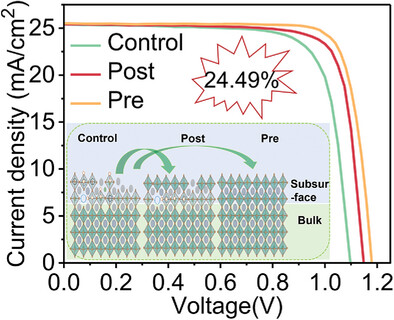
The subsurface of perovskite (PVK) films produced via the solution method exhibits impurities and a high concentration of defects. This paper examines the limitations of conventional post-treatment strategies for regulating the subsurface of PVK films and introduces an innovative pre-treatment strategy aimed at improving the quality of the film subsurface.
Self-Standing Biohybrid Xerogels Incorporating Nanotubular Clays for Sustainable Removal of Pollutants
- First Published: 17 November 2024

A scalable and systematic protocol for the preparation of colloidal dispersions and the corresponding hydrogels and xerogels is designed by using natural halloysite nanotubes and chitosan. Xerogels maintain the morphological properties due to the presence of nanoclays. The materials can be exploited for pollutants capture from both aqueous and gas phases, being efficient for environmental remediation.
Self-Healing and Antifreezing/Antidrying Conductive Eutectohydrogel-Based Biosignal Monitoring Multisensors with Integrated Supercapacitor
- First Published: 22 November 2024
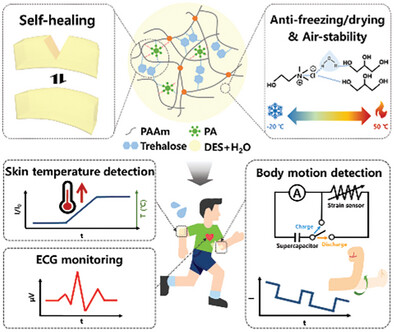
This work reports on the synthesis of a novel self-healing and antifreezing/antidrying conductive eutectohydrogel, with its application to wearable multifunctional sensors and supercapacitors. With the eutectohydrogel-based devices, various biosignals including skin temperature, body movements, and electrocardiogram signals are detected while attached onto skin, recovering the performance even after multiple times self-healing from damages.
Sowing Clean-Release Salt Catalyst for the Synthesis of Contamination-Free Single-walled Carbon Nanotube Arrays
- First Published: 20 November 2024
Disintegration of Thin Liquid Metal Films Engendered by Aluminum Corrosion
- First Published: 17 November 2024

An intriguing phenomenon that liquid metal films disintegrate on encountering water is introduced, which is attributed to the aluminum corrosion-triggered dewetting. Based on it, novel concepts for fabricating liquid metal microdroplets, transient circuits, welding agents, and information encryption are proposed. It provides a scientific insight into ephemeral art and makes the Ga─Al combination more illuminating.
Decoupled Water Reduction and Hydrazine Oxidation by Fast Proton Transport MoO3 Redox Mediator for Hydrogen Production
- First Published: 18 November 2024
Multifunctional Network-Shaped Hydrogel Assemblies
- First Published: 26 November 2024

Previously reported hydrogel assemblies are bulky shapes, thus these assembly forms greatly limited their further applications. However, in nature, there are many attractive examples of animal-built network assemblies, which are inspired by the new construction approach of hydrogel assemblies. Here, the multifunctional network-shaped hydrogel assemblies prepared by three -dimension-printed hydrogel blocks of varying shapes and properties are reported.
Single-Entity Electrochemistry of N-Doped Graphene Oxide Nanostructures for Improved Kinetics of Vanadyl Oxidation
- First Published: 16 November 2024

Isolated N-doped graphene oxide flakes are characterized using scanning electrochemical cell microscopy (SECCM) to investigate their performance in V(V/IV) reactions. The response of sub-domains is heterogeneous even within a single flake. However, very fast charge transfer is observed at defect sites, indicating that these nanomaterials hold great potential as building blocks for high-performing electrodes in redox flow battery applications.
Engineering Nano-Pills to Inhibit Ovarian Cancer Proliferation and Migration through a Combination of Chemical/Nucleic Acid Therapy
- First Published: 22 November 2024
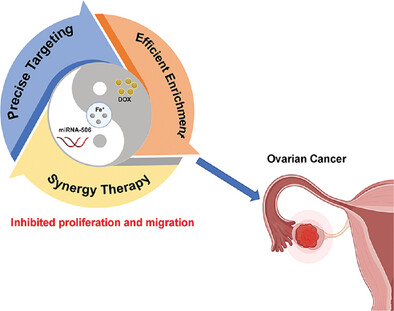
An intelligent aptamer-engineered TAM membrane-encapsulated nanopill has been fabricated, enabling precise targeting of ovarian cancer cells and facilitating the effective delivery of miRNA and chemical drugs for synergistic therapy. This work represents a new paradigm in combining nucleic acid therapy and chemotherapy within engineered nanopills.
Highly Water-Stable 2D MOF as Dual Sensor for the Ultra-Sensitive Aqueous Phase Detection of Nitrofuran Antibiotics and Organochlorine Pesticides
- First Published: 20 November 2024
Sabatier Principle-Driven Single-Atom Coordination Engineering for Enhanced Fenton-Like Catalysis
- First Published: 22 November 2024
Extreme Toughening of Conductive Hydrogels Through Synergistic Effects of Mineralization, Salting-Out, and Ion Coordination Induced by Multivalent Anions
- First Published: 22 November 2024
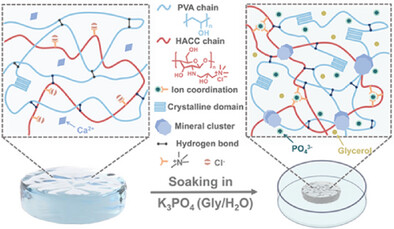
Harnessing the diverse properties of multivalent anions, a novel strategy is introduced for fabricating exceptionally robust hydrogels through the synergistic effects of mineralization, salting-out, and ion coordination induced by multivalent anions. The combined toughening mechanisms significantly enhance the mechanical properties and conductivity of the hydrogel, demonstrating its potential for use in mechanically durable solid-state supercapacitors.
Defect Engineering Enhancing Piezoelectric Catalytic Activity of Covalent Organic Framework Matrix Composites for Uranium Removal
- First Published: 01 December 2024
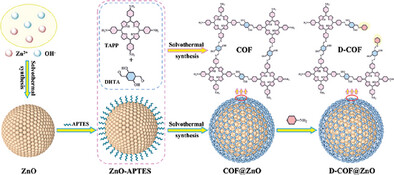
In this study, a defect heterogeneous engineering approach Is adopted, where covalent organic frameworks (COFs) are grown in situ on the surface of zinc oxide (ZnO) through a Schiff base reaction, and defects are introduced into the COF shell layer by means of an imine exchange reaction to construct D-COF@ZnO for piezoelectric-catalyzed uranium removal.
Reference-Attached pH Nanosensor for Accurately Monitoring the Rapid Kinetics of Intracellular H+ Oscillations
- First Published: 21 November 2024
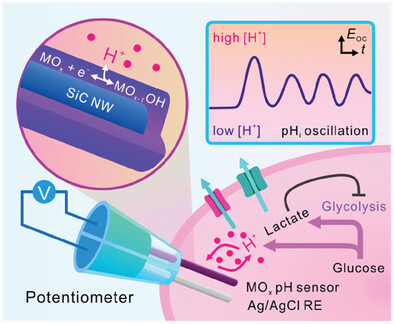
A reference-attached pH nanosensor is developed with the capability to timely and accurately monitor rapid intracellular pH variation. This nanosensor successfully tracks asymmetric pH fluctuations during glycolysis in cancer cells, reveals faster production of acidic metabolites over their removal, and clarifies the inhibitory effects of lactate rather than H+ to glycolysis.
Synergistic Doping Strategy with Novel Multi-Carbonyl Conductive Polymer Enables Stable Self-Powered Perovskite Photodetectors
- First Published: 09 December 2024
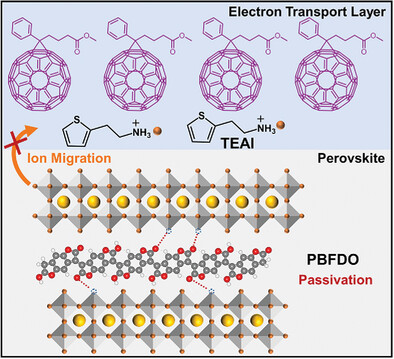
A synergistic doping strategy is demonstrated to enhance the humidity stability of lead halide perovskites. Multi-carbonyl polymer poly(benzodifurandione) is doped in perovskites to reduce defect density, and organic iodide thiophene-2-ethylammouium iodide TEAI is added to transport layer to inhibit ion migration. Optimized photodetectors show enhanced stability, maintaining 90% initial photocurrents after 87 days in 60% RH atmosphere at room temperature.
The Key Role of N/S Codoped Carbon Dots in Efficient Capture and Conversion of Lithium Polysulfides
- First Published: 17 November 2024
Buried Interface Modification Toward Efficient CsPbI2.2Br0.8 Based Monolithic Perovskite/Organic Tandem Solar Cells
- First Published: 20 November 2024
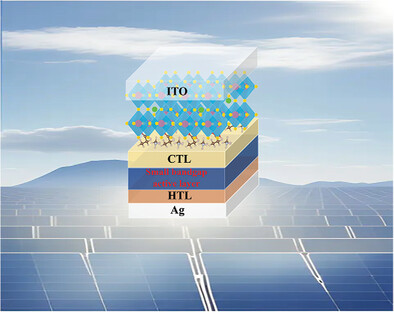
An efficient ionic liquid, methylamine propionate (MAPA), is adopted to modify the buried interface of all-inorganic perovskite films by establishing a strong interaction with the Pb–Pb dimer, which promotes a high power conversion efficiency (PCE) of 18.28% for CsPbI2.2Br0.8-based all-inorganic wide-bandgap perovskite solar cells (AIWPSCs), and a high PCE of 23.19% for n-i-p structured perovskite/organic tandem solar cells (POTSCs).
Enhanced Hole-Injecting Interface for High-Performance Deep-Blue Perovskite Light-Emitting Diodes Using Dipole-Controlled Self-Assembled Monolayers
- First Published: 26 November 2024
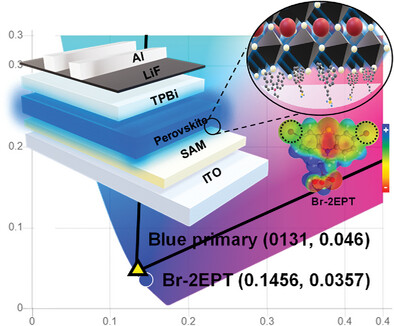
In this study, an enhanced hole-injecting interface for deep-blue perovskite light-emitting diodes is demonstrated through the application of dipole-controlled self-assembled monolayer (SAMs). The SAM-modified hole-injecting interface exhibits optimal energy band alignment, a reduced defect density at the buried interface, and improved hole injection efficiency into the perovskite emitting layers, outperforming the performance of conventional hole-injecting materials, such as PEDOT:PSS.
Constructing Nitrogen-Coordinated Single Atom Catalysts via Bond-Plucking Strategy for Oxidation of Benzene
- First Published: 21 November 2024
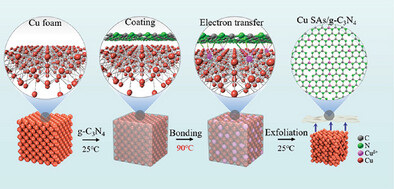
A novel bond-plucking strategy is developed to synthesize Cu single-atom catalysts (Cu-SACs) with well-defined Cu-N3 moieties, greatly simplifying the synthetic process, decreasing production costs. The obtained Cu-SACs present high performance for selective oxidation of benzene to phenol. This work paves a new pathway to construct well-defined SACs at low cost, promoting large-scale production and industrial application.
Lubricating and Dual-Responsive Injectable Hydrogels Formulated From ZIF-8 Facilitate Osteoarthritis Treatment by Remodeling the Microenvironment
- First Published: 27 November 2024
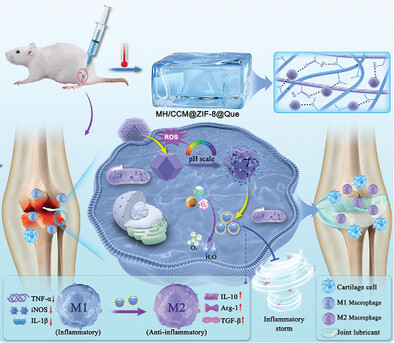
OA is a progressive disease marked by articular cartilage degeneration and bone hyperplasia; seeking to restore joint microenvironment balance is crucial for management. This study presents a double-responsive injectable hydrogel based on ZIF-8 that enhances the microenvironment and promotes cartilage repair via controlled release of bioactive substances.
Fine Tuning of Torus-Shaped Mo-Doped Ni2P Nanorings for Enhanced Seawater Electrolysis
- First Published: 24 November 2024
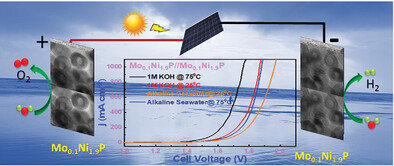
Torus-shaped Mo0.1Ni1.9P nanoparticles having hollow nanorings at the center are synthesized using a single-step one-pot colloidal synthesis method. The nanoring particles act as highly efficient standalone electrocatalysts for alkaline water and seawater splitting at low cell voltage with high turnover frequency. This novel catalyst offers high stability under industrial harsh conditions.
Engineering 2D Materials from Single-Layer NbS2
- First Published: 25 November 2024
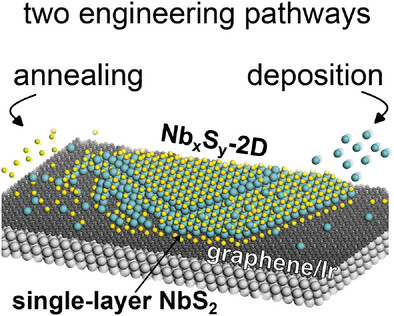
Starting from a single-layer NbS2 on graphene, new 2D materials Nb5/3S3-2D and Nb2S3-2D are synthesized via sulfur-deficient annealing or Nb deposition at elevated temperatures. These covalently bound materials exhibit unique structures influenced by surface effects, differing from expected bulk stacking sequences.
Ni Vacancy and the Se/S Ratio Regulate the p-Band Center of Hollow NiSxSe2-x/Phase Junction CdS to Achieve High Efficiency and Broad-Spectrum Photocatalytic Performance
- First Published: 24 November 2024
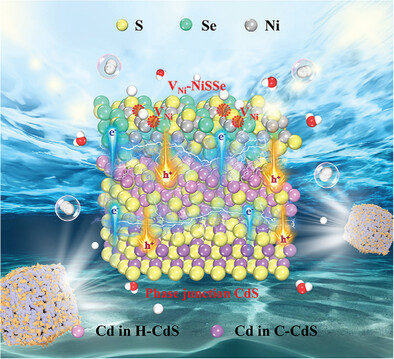
This work adopts a multi-strategy involving the introduction of Ni vacancies, the adjustment of the Se/S ratio, and the construction of dual junctions on VNi-NiSSe/phase junction CdS, aiming to boost photocatalytic H2 efficiency. The optimal performance is ascribed to the electron redistribution to occupy more antibonding orbitals and adjust the p-band center and the strong gradient interfacial interaction.
Gut-on-a-Chip Reveals Enhanced Peristalsis Reduces Nanoplastic-Induced Inflammation
- First Published: 25 November 2024
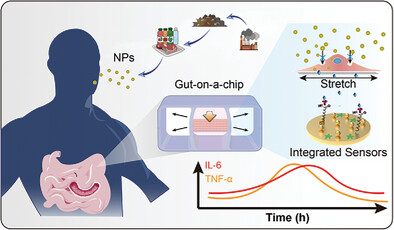
A gut-on-a-chip with integrated sensors is utilized here to examine the effects of nanoplastics (NPs) on intestinal inflammation. Results demonstrate that NPs cause cellular damage and elevate interleukin-6 (IL-6) and tumor necrosis factor alpha (TNF-α) levels. Enhancing peristaltic activity significantly reduces inflammatory cytokines by over twofold, highlighting peristalsis as a potential protective mechanism against inflammation.
Structural and Electronic Modulations of Se-Vacancy-Rich MoSe2 Triggered by Cr Doping toward Robust Nitrogen Reduction Reaction
- First Published: 22 November 2024
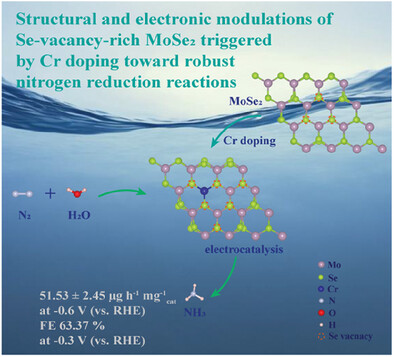
The Cr doping not only induces VSe to offer more active sites for NRR but also regulates the electronic structure to optimize the adsorption of intermediates. Consequently, suitable Cr doping remarkably enhances NRR activity while easing the competitive HER, delivering MoSe2 a superior NH3 yield of 51.53 µg h−1 mg−1cat and FE of 63.37%, outperforming most reported NRR catalysts.
Facilitating Oriented Electron Transfer from Cu to Mo2C MXene for Weakened Mo─H Bond Toward Enhanced Photocatalytic H2 Generation
- First Published: 27 November 2024
A Multifunctional MXene/PVA Hydrogel as a Continuous Ionic Thermoelectric Generator and a Strain/Temperature Sensor
- First Published: 20 November 2024
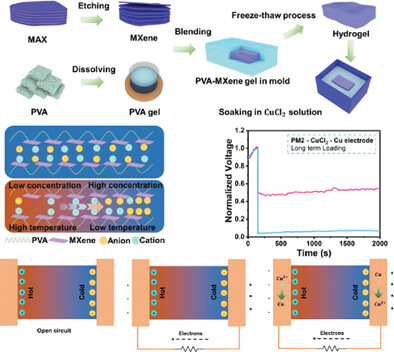
A continuous-output ion thermoelectric generator based on the redox reaction of Cu/Cu2+ embedded in a flexible MXene/PVA hydrogel is developed to harvest near-room-temperature heat. The thermopower is enhanced by reducing the diffusivity of ions via the addition of MXene. The device also functions as a multifunctional strain and temperature sensor.
Multifunctional Scaffold Comprising Metal–Organic Framework, Hydrogel, and Demineralized Bone Matrix for the Treatment of Steroid-Induced Femoral Head Necrosis
- First Published: 22 November 2024
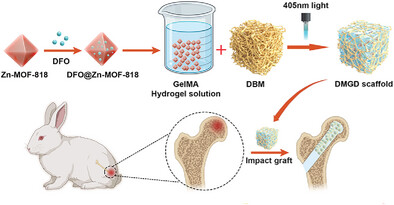
Inspired by natural enzyme Cu/Zn-superoxide dismutase, Zn-modified metal-organic framework 818 (Zn-MOF-818) is synthesized by substituting copper in MOF-818 with zinc, leading to significantly enhanced superoxide dismutase- and catalase-like activities. Subsequently, it developed a biomimetic multifunctional scaffold comprising deferoxamine@Zn-MOF-818, gelatin methacryloyl hydrogel, and demineralized bone matrix to scavenge reactive oxygen species, promote angiogenesis, and regulate local immunity, thus providing an optimal environment for osteogenesis.
Thiol Groups Reutilization on Chemical Bath Deposited Tin Oxide Surface Achieving Interface Anchoring and Defects Passivation for Enhancing the Performance and Stability of Perovskite Solar Cells
- First Published: 25 November 2024
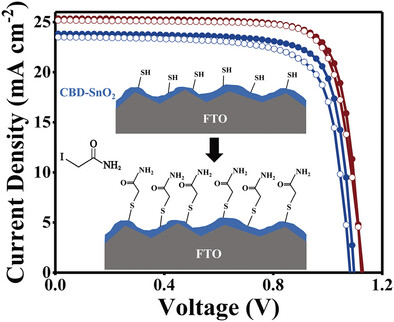
A method for the reutilization of CBD-SnO2 surface groups to construct a molecular bridge based on iodoacetamide is proposed. This strategy increases the carrier mobility of the CBD-SnO2 and assists the perovskite grain crystallization. The strategy demonstrates the potential of reutilization of the surface groups to enhance the performance of PSCs.
Multilevel and Flexible Physical Unclonable Functions for High-End Leather Products or Packaging
- First Published: 25 November 2024
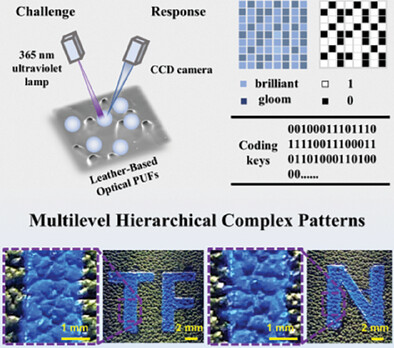
The flexible leather-based optical PUF with anticounterfeiting ability and excellent mechanical properties is prepared by utilizing the unclonable metasurface of leather and the photoluminescence of CO/Cs2AgBiBr6 QDs for the first time. The complex encryption of leather-based optical PUF is realized by combining the leather texture-determined unpredictable fluorescence intensity with a self-defined macroscopic fluorescence pattern.
Dynamically Reconstructed Fe-CoOOH Semi-Crystalline Electrocatalyst for Efficient Oxygen Evolution Reaction
- First Published: 24 November 2024
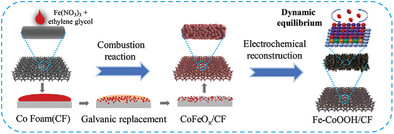
CoFeOx undergoes quick chemical and slow morphological reconstruction to Fe-CoOOH nanosheets which possess a semi-crystalline nature with distinct short-range ordering and outstanding OER activity with remarkable stability. Theoretical calculations confirm the crucial role of Fe doping in modulating the electronic density, facilitating surface reconstruction, enhancing OER activity, and improving the stability of the Fe-CoOOH.
Solvent-Free Ball Milling Synthesis of Water-Stable Tin-Based Pseudohalide Perovskites for Photocatalytic CO2 Reduction
- First Published: 28 November 2024
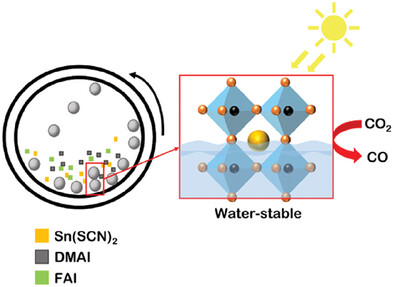
Pseudohalide tin perovskites synthesized via a solvent-free ball milling method demonstrate enhanced water stability and photocatalytic CO2 reduction efficiency. By incorporating DMA cations, the materials exhibit improved hydrophobicity and electronic properties, achieving sustainable performance without sacrificial reagents. This study provides an eco-friendly approach to designing stable, high-performance perovskite-based photocatalysts for carbon capture and utilization.
High Proton Conductivity of Acid Impregnated COFs Stabilized by Post-Oxidation
- First Published: 25 November 2024

A covalent organic framework (COF) characterized by outstanding chemical stability and high crystallinity is prepared through the method of imine-to-amide post-oxidative conversion. The synthesized COF exhibits tolerance to strong proton acids and achieves outstanding proton conductivity with an exceptionally low activation energy.
Cross-Linked Polyamide-Integrated Argyrodite Li6PS5Cl for All-Solid-State Lithium Metal Batteries
- First Published: 22 November 2024
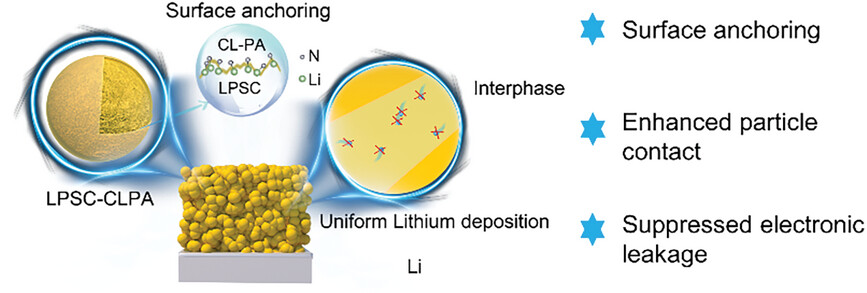
By capitalizing on the surface electrostatic potential difference, a cross-linked polyamide (CL-PA) interphase is chemically anchored to the Li6PS5Cl electrolyte. This interphase engineering strategy enhances interparticle contact, suppresses electron leakage at grain boundaries, and significantly improves the critical current density of the LPSC electrolyte, enabling its application in high-performance all-solid-state lithium metal batteries with promising commercial potential.
Mitigating Zinc Dendrite Formation and Parasitic Side Reactions in Aqueous Zn-Ion Batteries Via Laser-Assisted Carbonization of Cu-PANI Films on Zn Anodes
- First Published: 09 December 2024

The study aims to improve the practical application of aqueous Zn-ion batteries (ZIBs) by designing a heteroatom-doped carbon porous layer using laser-assisted carbonization of copper-doped polyaniline (c-Cu-PANI). This modification enhances electrochemical stability, suppresses dendrite formation, and mitigates parasitic reactions. The c-Cu-PANI/Zn anodes show superior cycling stability and Coulombic efficiency, offering a promising strategy for improving the performance and commercial viability of aqueous ZIBs.
Unraveling the Nature of Interfacial Behavior in the LiTFSI-LiCl Aqueous Biphasic System
- First Published: 25 November 2024
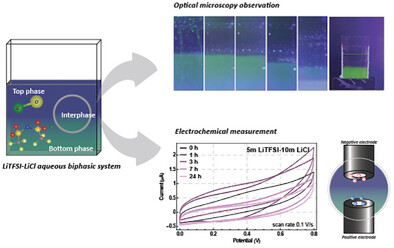
The study examines the interfacial stability of an aqueous biphasic system (ABS) using lithium bis(trifluoromethanesulfonyl)imide and lithium chloride (LiTFSI-LiCl) electrolytes. Findings reveal liquid-liquid instability and solid phase formation at the interphase over time, observed via optical microscopy and electrochemical measurements. These insights are crucial for improving ABSs in applications, emphasizing the significance of maintaining stable interphases for electrochemical performance.
ROS Responsive Cerium Oxide Biomimetic Nanoparticles Alleviates Calcium Oxalate Crystals Induced Kidney Injury via Suppressing Oxidative Stress and M1 Macrophage Polarization
- First Published: 04 December 2024
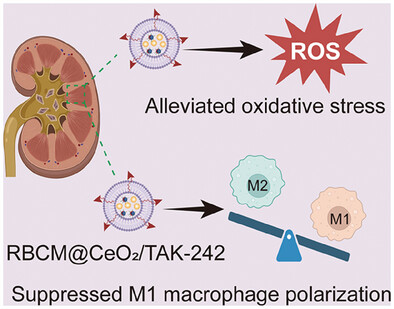
Reactive oxygen species (ROS)-responsive biomimetic nanoparticles show excellent injured kidney targeting. RBCM@CeO2/TAK-242 alleviates CaOx induced kidney injury and reduces crystals deposition. RBCM@CeO2/TAK-242 nanoparticles could inhibit oxidative stress and M1 macrophage polarization. RBCM@CeO2/TAK-242 protected against CaOx induces kidney injury by suppressing TLR4/NF-κB pathway.
Zwitterionic Polymer Lipid Nanoparticles Enabling Selective Organ Targeting Delivery of Small Interfering RNA for the Treatment of Hepatic and Pulmonary Inflammation
- First Published: 04 December 2024
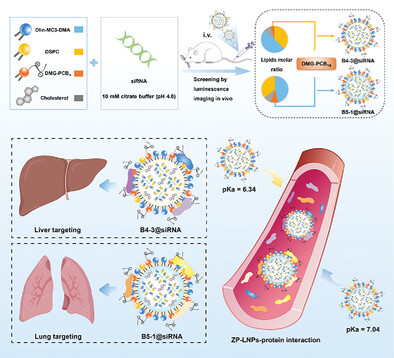
Zwitterionic polymer lipid nanoparticles (ZP-LNPs) are assembled with three lipids and zwitterionic polymer polycarboxybetaine (PCB) modified lipid DMG-PCBn. B4-3@siRNA and B5-1@siRNA screened from 90 ZP-LNPs can selectively deliver siRNA to the liver and lung, respectively, which is mediated by the different pKa and protein corona. ZP-LNPs show promising application for the treatment of diseases associated with the liver and lung.
Fine-Tuning Conformation of PEDOT Chains Enables Simultaneously Enhanced Conductivity, Work Function, Transmittance, and Waterproofness in PEDOT:PSS Interlayer for Highly Efficient and Stable Organic Photovoltaics
- First Published: 18 November 2024

The conformation of PEDOT chains are regulated from helical benzoyl to linear quinone structure via incorporation of 2D Cd0.85PS3Li0.15H0.15 dopant into the conventional PEDOT:PSS interlayer. As a result, the PCE of OPVs based on D18:L8-BO is boosted from 18.37% to 19.26%. The application of Cd0.85PS3Li0.15H0.15 doping PEDOT:PSS strategy demonstrates great potential for the development of strongly conductive, large-work-function, highly transparent, and excellent-waterproof PEDOT:PSS interlayer toward highly efficient and stable OPVs.
An Amphiphilic Molecule Induced Anion-Enrichment Interface for Next-Generation Lithium Metal Batteries
- First Published: 22 November 2024
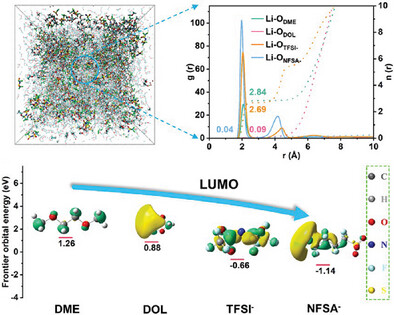
An amphiphilic molecule nonafluoro-1-butanesulfonate (NFSA) is employed in electrolytes to realize anion-enrichment interfacial design. The polar lithophilic segments (-SO3-) present a capability to solvate Li+ ions, while the perfluoroalkyl chains (-CF2CF2CF2CF3) exhibit a solvent-phobic, which alters the Li+ solvation environment in the electrolyte and thus building a favorable interphase enriched with anion-derived inorganic compositions on Li electrode.
Surface Engineering of Copper Foam to Construct a Hierarchical Heterostructure for High Energy Efficient Supercapacitors
- First Published: 22 November 2024
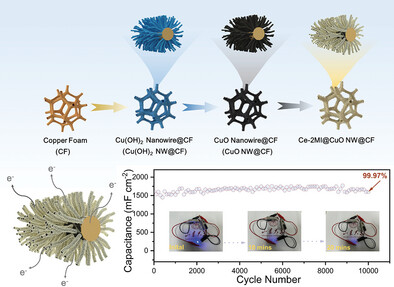
An elaborate surface engineering of copper foam substrate is adopted for constructing the current-collector-free and binder-free supercapacitor electrodes of hierarchically heterostructured Ce-2MI@CuO NW@CF. As-assembled three-electrode supercapacitors of Ce-2MI@CuO NW@CF are endowed with excellent cycling stability and a superior capacity, and the corresponding asymmetrical supercapacitor device can light up a light-emitting diode bulb for 20 min.
Ferroelastic Domain Switching and Time-Resolved Negative Capacitance in Polar-Axis-Oriented Hf0.5Zr0.5O2 Grown by Atomic Layer Epitaxy
- First Published: 15 December 2024
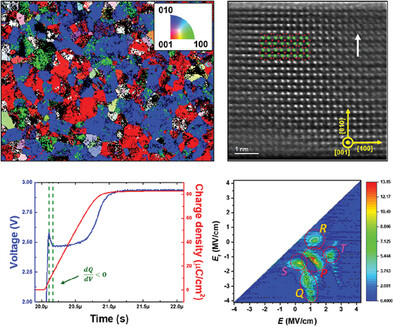
A breakthrough in epitaxial (001)-oriented Hf0.5Zr0.5O2 films grown by atomic layer epitaxy is demonstrated, achieving a record-high ferroelectric polarization of 78.9 µC cm−2. This study establishes a two-step, 90° ferroelastic domain switching model and highlights the significance of crystallographic orientation, providing key insights into polarization dynamics and negative capacitance in ferroelectrics.
Enhancing Potassium-Ion Storage through Nanostructure Engineering and Ion-Doped: A Case Study of Cu2+-Doped Co0.85Se with Yolk-Shell Structure
- First Published: 01 December 2024
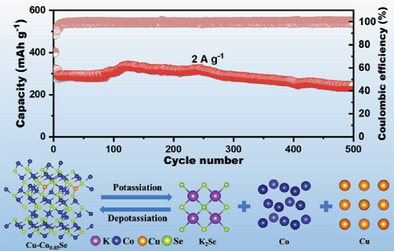
The Cu-Co0.85Se@NC-2 anode with an optimal concentration of Cu2+-doped and yolk-shell structure is developed to enhance the reaction kinetics and cycling life. The Cu2+-doped modulates the electronic structure of the Co0.85Se interface, improves the diffusion and adsorption of K+, and further promotes the charge transport efficiency. Both coin-type and pouch cells show outstanding rate performance and ultra-long life.
Interface Engineering for Improved Large-Current Oxygen Evolution via Partial Phosphorization of Ce-MOF/NiCo-MOF Heterostructure
- First Published: 22 November 2024
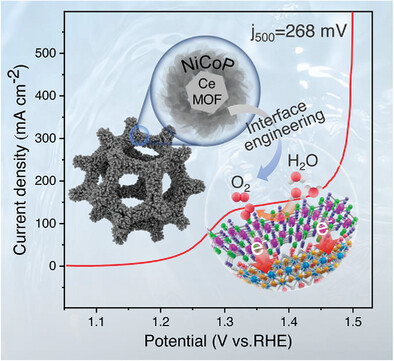
This work in situ synthesized NiCo-metal-organic framework (MOF)/Ce-MOF heterostructure by one-step hydrothermal reaction. Then the external NiCo-MOF is transformed into NiCoP by a low-temperature partial phosphorization treatment while the internal Ce-MOF remained its hexagon structure. This novel interface engineering can enhance the electron transfer rate thus improving the activity of electrocatalytic oxygen evolution reaction under large current density.
High-Performance Flexible and Symmetric Supercapacitors Based on Micro-Flower-Like MnSe@Ti3C2Tx Heterostructure
- First Published: 24 November 2024

MnSe@Ti3C2Tx electrode material exhibits excellent electrochemical properties owing to the exceptional conductivity of Ti3C2Tx, Faraday pseudocapacitance characteristics imparted by MnSe, and the unique heterostructured micro-flower structure of the electrode material. The MnSe@Ti3C2Tx electrode material proposed in this study offers a novel approach for modifying Ti3C2Tx-based electrode materials and also provides an effective strategy for the development of flexible supercapacitors.
Multifunctional Regulation of Chemical Bath Deposition Based SnO2 for Efficient Perovskite Solar Cells
- First Published: 20 November 2024
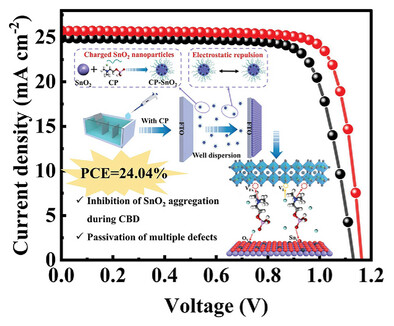
A feasible strategy using a multifunctional phosphorylcholine chloride (CP) is developed, not only beneficial for regulation of chemical bath deposition (CBD) SnO2 to inhibit the aggregation of nanoparticles, but passivating the defects both in the film and at the buried interface of SnO2/perovskite, contributing to the power conversion efficiency (PCE) of perovskite solar cells (PSCs) significantly improved to 24.04% (over 21.55%) with improved long-term stability.
Reprogrammed Lung Metastasis Immunodeficiency via Targeted Penetrated Delivery of M1 Macrophage-Wrapped NanoCubes-Mediated T Cell Infiltration
- First Published: 22 November 2024
Remodel Heterogeneous Electrical Microenvironment at Nano-Scale Interface Optimizes Osteogenesis by Coupling of Immunomodulation and Angiogenesis
- First Published: 18 December 2024
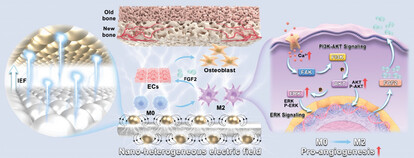
By decoration of isolated bismuth oxide nanodots on titanium dioxide nanofibers, heterogeneous electric field is constructed by the well-distributed nano-heterojunctions to promote bone regeneration. The heterogeneous electrical microenvironment facilitates coupling of immunomodulation and angiogenesis, as well as pro-angiogenic transformation of macrophages, which are mainly mediated by enhancement of calcium ion influx and subsequent activation of PI3K signaling cascades.
Effect of Different Molten Salts on Structure and Water Splitting Performance of Al-Doped Fillet Polyhedral SrTiO3
- First Published: 01 December 2024
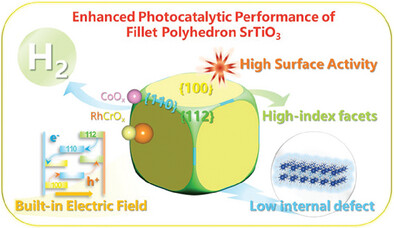
Al-doped fillet polyhedral SrTiO3 exhibits high surface activity and low defect density, exposing anisotropic facets, particularly high-index facets {112}. This structure forms a built-in electric field, which enhances photocarriers separation and transfer, reduces recombination rate, and thereby improves their lifetime and utilization. When loaded with RhCrOx/CoOx cocatalysts, the material demonstrates significant advantages in photocatalytic water splitting for hydrogen production.
Confined Magnetization at the Sublattice-Matched Ruthenium Oxide Heterointerface
- First Published: 22 November 2024
Cellulose Nanocrystal Composite Membrane Enhanced with In Situ Grown Metal–Organic Frameworks for Osmotic Energy Conversion
- First Published: 22 November 2024

A nanofluidic membrane consisting of self-assembled biomass-derived cellulose nanocrystals and in situ-grown metal-organic frameworks is developed to harvest and convert salinity gradient energy. This work presents an exploration of creating the core nanofluidic membrane for salinity gradient energy conversion from well-resourced, eco-friendly, and sustainable biomass materials by using a simple, cost-effective, and low-emission fabrication strategy.
Constructing Dense CoRu-CoMoO4 Heterointerfaces with Electron Redistribution for Synergistically Boosted Alkaline Electrocatalytic Water Splitting
- First Published: 26 November 2024
Modulating the Iron Microenvironment for a Cooperative Interplay Between Fe-N-C Single Atoms and Fe3C Nanoclusters on the Oxygen Reduction Reaction
- First Published: 26 November 2024

Model Fe-N-C catalysts for the oxygen reduction reaction (ORR) are developed in such a way that they feature either FeN4 single-atoms, Fe3C nanoclusters, or a combination of both. Experiments demonstrate improved ORR performance in terms of catalytic activity and selectivity thanks to the synergy between single-atoms and nanoclusters, further supported by DFT calculations.
Ultralow Lattice Thermal Conductivity and High ZT Beyond 1 Realized in Bi2S3 Nanocomposites via Bottom-Up Structure Design
- First Published: 05 December 2024
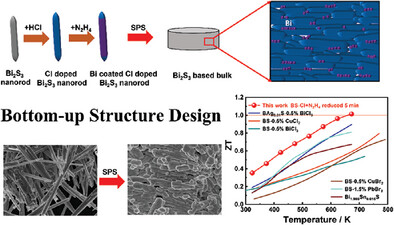
This work offers a bottom-up strategy to improve thermoelectric properties. By adjusting the properties of microstructural units and then designing and preparing bulk materials, the transport properties are modulated to optimize thermoelectric properties. The ZT value of Bi2S3 system reaches 1 at 673 K for the first time, indicating its potential for business application.
A Bifunctional Iron-Nickel Oxygen Reduction/Oxygen Evolution Catalyst for High-Performance Rechargeable Zinc–Air Batteries
- First Published: 27 November 2024
Harnessing the Engineered Probiotic-Nanosystem to Remodulate Tumor Extracellular Matrix and Regulate Tumor-Colonizing Bacteria for Improving Pancreatic Cancer Chemo-Immunotherapy
- First Published: 24 November 2024
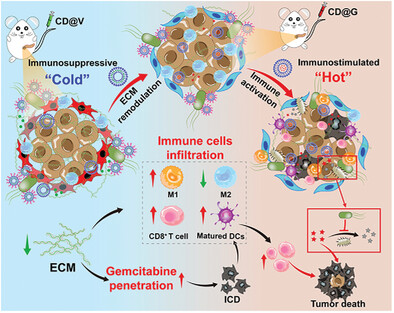
The engineered probiotic-nanosystem effectively enhances the GEM-induced ICD and promotes the penetration of tumor-suppressive immune cells in pancreatic tumors, resulting in a robust immune response, which transformed the immunosuppressive pancreatic tumor into immunostimulated one and remarkably improved the chemo-immunotherapy in pancreatic cancer.
High Performance Perovskite Photodiodes via Molecule-Assisted Interfacial and Bulk Modulations
- First Published: 24 November 2024
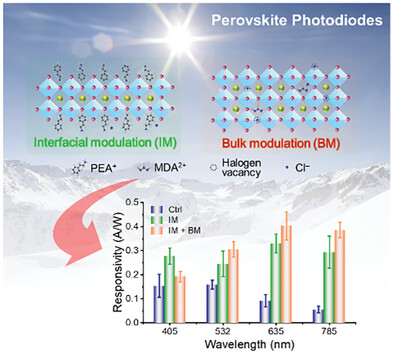
Through molecular engineering of interfacial and bulk modulations, the photoresponse of metal halide perovskite photodiodes has been significantly enhanced. The responsivity reaches 0.40 A W−1, with a detectivity exceeding 10¹¹ Jones, and a rapid response time of ≈1 µs. Additionally, the photocurrent displays a U-shaped temperature dependence over the range of 10 to 300 K.
High Entropy Oxide Duplex Yolk–Shell Structure with Isogenic Amorphous/Crystalline Heterophase as a Promising Anode Material for Lithium-Ion Batteries
- First Published: 28 November 2024

A novel high entropy oxide ((CrMnFeCoNi)3O4) duplex yolk–shell structure (DYSHEO-450) with isogenic amorphous/crystalline heterophase are designed and successfully prepared through a simple microthermal solvothermal reaction followed by mesothermal calcination. When used as LIB anode material, DYSHEO-450 exhibits high capacities of 1721 mAh g−1@0.5 A g−1, and 1356 mAh g−1@1 A g−1 after 500 cycles with a capacity retention rate of 90.3%.
CO2-Mediated Hydrogen Energy Release-Storage Enabled by High-Dispersion Gold-Palladium Alloy Nanodots
- First Published: 20 November 2024
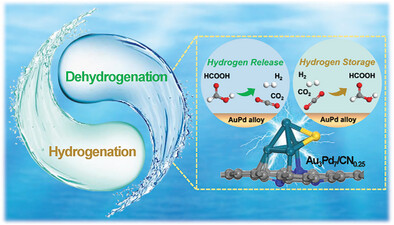
Room-temperature formic acid dehydrogenation coupled with CO2 hydrogenation back to formic acid is significantly enabled by pyridinic-nitrogen-modified carbon-loaded AuPd alloy nanodots with a prominent electron synergistic effect, achieving a full carbon-neutral CO2-mediated green hydrogen energy release-storage system using a single heterogeneous catalyst.
Thienothiophene-Benzopyran Derivative and AQ4N-Assembled Liposomes for Near-Infrared II Fluorescence Imaging-Guided Phototherapy, Chemotherapy, and Immune Activation
- First Published: 20 November 2024

This report designed and synthesized a thienothiophene-benzopyran derivative (BTPIC4F-C10) with NIR absorption and fluorescence properties, and constructed liposome nanoparticles (LipBFCA NPs) that encapsulated BTPIC4F-C10 and the hypoxia-activated prodrug AQ4N. Under 808 nm laser irradiation, ultra-high photon energy utilization efficiency (99%) endowed LipBFCA NPs with excellent PDT and PTT therapeutic effects. In addition, chemotherapy and immune activation enhance the therapeutic effect.
Conductive Porous Solid Framework Mechanically Stabilized Si Anode
- First Published: 26 November 2024
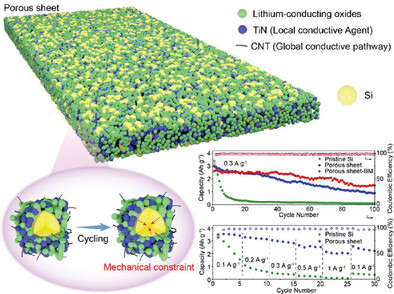
A porous sheet with a solid framework, which includes both local and global conductive networks, is constructed to enclose micron-sized Si particles. This porous sheet can mechanically constrain micron-sized Si, suppressing its volume change during the cycling process, thereby improving the cycling stability of micron-sized Si and exhibiting excellent rate performance.
Robust Multifunctional Films with Excellent EMI Shielding, Anti-Peeling, and Joule Heating Performances Enabled by an Encapsulated Highly Conductive Fabric Strategy
- First Published: 27 November 2024

Combined with an encapsulated conductive fabric strategy and anti-peeling treatment, robust and durable multifunctional flexible films are fabricated. Benefiting from the embedded shielding-absorbent integrated fabric and conductive encapsulation layer, superior absorption-dominated EMI shielding and Joule heating performances are achieved by AMNs. This work provides a promising fabrication scheme for high-performance multifunctional films.
Ultrafast Self-Gelling, Adhesive, Anti-Bacterial Coacervate-Based Powders for Enhanced Hemostasis and Wound Healing
- First Published: 01 December 2024
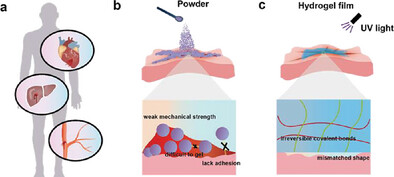
PQPP, a novel self-gelling hemostatic powder, rapidly absorbs blood and forms a robust adhesive hydrogel within 2 s. Composed of polyacrylamide/quaternized chitosan and polydopamine nanoparticles, it effectively seals wounds, resists high-pressure blood flow, and exhibits excellent biocompatibility and antibacterial properties. PQPP offers a promising solution for immediate wound management in surgical and emergency care.
Editor's Choice
Nanostructure and Photovoltaic Potential of Plasmonic Nanofibrous Active Layers
- First Published: 22 November 2024
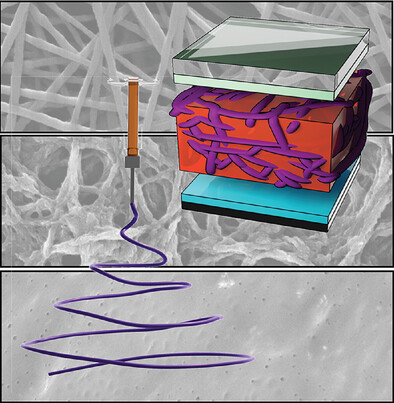
Nanofibrous active layers, created by electrospinning webs of ultrafine poly(3-hexylthiophene) (P3HT) nanofibers infiltrated by [6,6]-phenyl-C61-butyric acid methyl ester (PCBM), offer hierarchical control over molecular structure and component domains. Its photovoltaic potential is assessed by determination of the crystallite nanostructure and evaluation of competitive exciton dissociation with 95%+ quenching efficiency. Further addition of plasmonic nanoparticles may improve charge carrier generation and/or lifetimes.
The Molecular Additive N-Acetyl-L-Phenylalanine Delays the Crystallization and Suppresses the Phase Impurity for Achieving Triple-Cation Perovskite Solar Cells with Efficiency Over 25%
- First Published: 24 November 2024
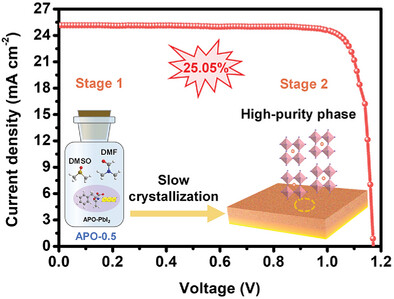
A molecular additive strategy, i.e., introducing non-planar molecule N-acetyl-L-phenylalanine (APO) into the lead iodide (PbI2) precursor solution, is proposed to modulate crystallization kinetics and inhibit the generation of phase impurities of metastable pretreated perovskite film. As a result, the target PSC devices achieve an impressive power conversion efficiency (PCE) of 25.05% and superior operational stability.
Multiplex Biomimetic SLIPS With Super-Lubricity to Multiphase Matters
- First Published: 26 November 2024
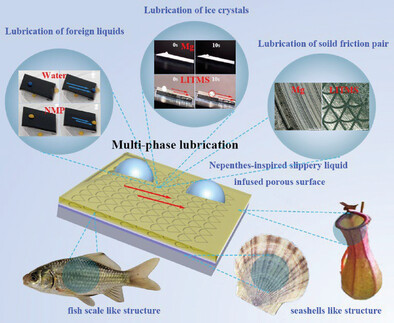
This study is inspired by fish scales, seashells, and Nepenthes, to design a multiplex biomimetic surface (LITMS) using laser-coating composite processing technology. LITMS exhibits remarkable repellency toward multiphasematerials. This preparation strategy for SLIPS provides new insights into interfacial phenomena and promotes advancements in applications for engineering material protection and machinery lubrication.
High-Density Dual Atoms Pairs Coupling for Efficient Electromagnetic Wave Absorbers
- First Published: 27 November 2024
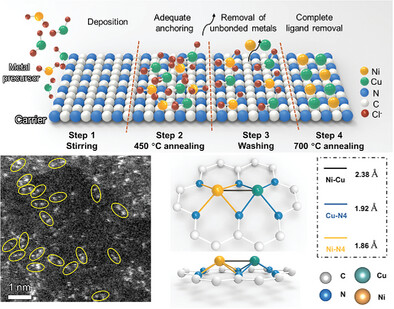
High-density coupled Ni─Cu dual-atom (DAs) absorbers are developed on a nitrogen-rich carbon substrate, achieving over double the previous loading. HAADF-STEM confirms metal-metal bonded pairs, and DFT calculations reveal that Cu's introduction optimizes the d-band center of Ni, facilitating charge redistribution and strong asymmetric polarization loss. DAs Ni2.5Cu2.5-NC demonstrates exceptional electromagnetic wave absorption performance, outperforming single-atom absorbers.
Responsive 3D Printed Microstructures Based on Collagen Folding and Unfolding
- First Published: 27 November 2024

Two-photon 3D laser printing of free-standing, fibrillar, and biocompatible 3D collagen microstructures is presented using a room temperature stable, easily accessible ink and a commercial setup. In addition, it is shown for the first time that 3D-printed collagen microstructures exhibit reversible response behavior, resulting in large volume shrinkage upon heating and cooling in multiple cycles.
Selective Hydrogen Oxidation Catalyst for PEM Fuel Cells: Tungsten Cluster-Tuned Platinum Single Atoms
- First Published: 22 November 2024
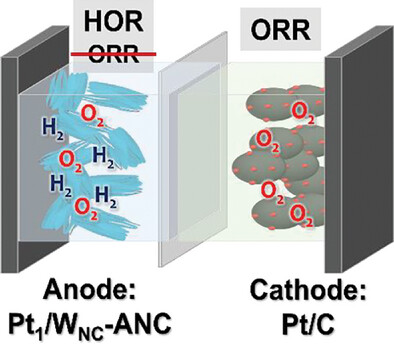
Proton-exchange membrane fuel cells often suffer from reverse-current degradation, which occurs when oxygen leaks into the anode. In this study, tungsten nanoclusters efficiently modulate the electronic structure of platinum single atoms, enhancing their hydrogen oxidation reaction activity while concurrently suppressing oxygen reduction reaction activity, thereby addressing a critical challenge in preventing reverse-current degradation.
Enhanced Electrostatic Dust Removal from Solar Panels Using Transparent Conductive Nano-Textured Surfaces
- First Published: 02 December 2024

Efficient, contactless, and waterless removal of dust from solar panels is imperative to large-scale solar farms. The study presents a transparent, nano-textured, and electrically conductive surface, that enables electrostatic cleaning of solar panels and retains high efficacy for small dust particles which are difficult to remove.
Lattice Regularization by Manipulating Over-Stoichiometric Defects Yields High-Performance (Bi,Sb)2Te3 Thermoelectrics
- First Published: 24 November 2024
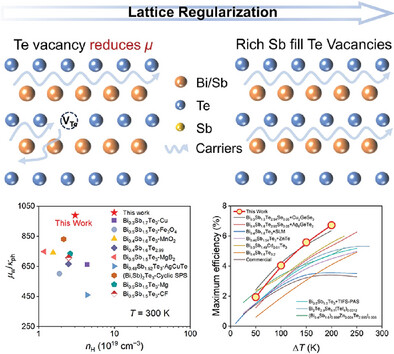
A novel “lattice regularization” strategy using over-stoichiometric Sb to fill Te vacancies, combined with trace Cu, enhances carrier mobility and global microstructural modulation in Bi0.496Cu0.004Sb1.52Te3, achieving a peak ZT of ≈1.50 at 350 K and an average ZT of 1.25. Notably, by integrating zone-melted Bi2Te2.7Se0.3, the 17-pair thermoelectric generator exhibits an impressive efficiency of up to 6.7% at ΔT = 200 K.
Pseudo-Nanostructuring and Grain Refinement Enhance the Near-Room-Temperature Thermoelectric Performance in n-type PbSe
- First Published: 26 November 2024
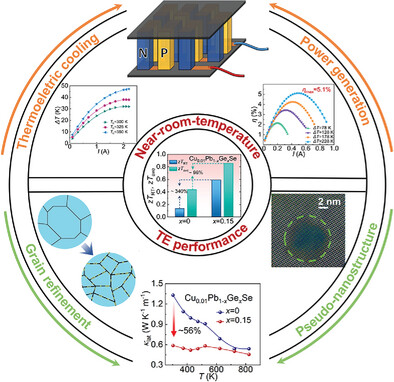
The introduction of high-concentration Ge into n-type Cu0.01PbSe enables grain refinement and the formation of pseudo-nanostructures. This innovative defect structure significantly enhances thermoelectric performance in the near-room-temperature range, thereby advancing the application of polycrystalline PbSe thermoelectrics in low-temperature power generation and thermoelectric cooling.





